KENYA!
Fall 2015 Photo Safaris
The Most Productive
Photo Safari Possible!
Our 28th Year doing Kenya Safaris!
Kenya's recent terrorism attacks were
hundreds of miles from any of our photo
destinations. On safari you are as safe as
you would be in Miami or New York, and
probably safer! We would not travel to
Kenya if we did not feel it was safe to do so.
No American Photographers have more
field experience leading photo safaris
to East Africa.
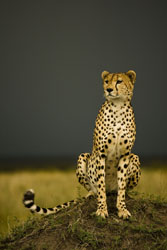



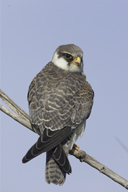
PRICES:
Trip #1: October 17-31, 2015 Price: $9,995
(single supplement $ 1,441 - high season)
Trip #2: November 7-21, 2015 Price: $9,995
(single supplement $ 1,300 - off-peak season)
Note: There is a 6 participant Rwandan Gorilla trek in between
our two Kenya photo safaris. You may wish to combine this
breath-taking experience with your photo safari.
To get the absolute most out of these safaris,
consider taking one of our
Complete Digital Nature Photo Courses
next summer!
PLEASE NOTE - Prices listed are based upon 10 participants.
There will be a small surcharge if the safari has fewer participants.
See below (What's Included) for the rationale and advantages.
If you're interested in one of our safaris, contact our office ASAP!
We are offering trips based on the land cost only.
We've done this to allow our participants to either utilize air miles,
or to amass air miles with their favorite airline.
Our travel agent can also book flight arrangements for you.
Simply inquire at our office for further details.
Special Photographic Safaris to the Top Three Game Parks:
Samburu Game Reserve, Lake Nakuru National Park, and the Masai Mara Game Reserve
An Exclusive Shoot
Limited to Ten Photographers
Two non-photographic spouse seats are available per safari
Only three photographers per Toyota LandCruisers
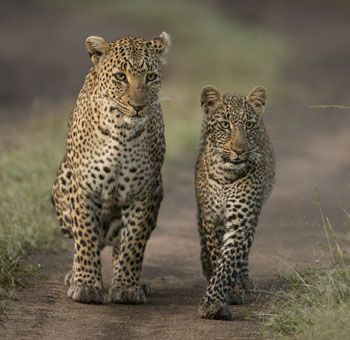
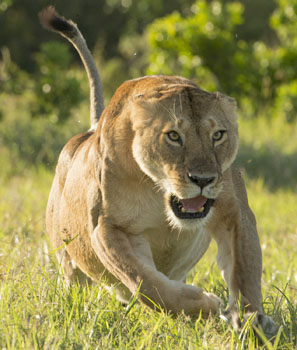
This is the complete brochure. It is lengthy and comprehensive, and will take a few minutes to read.
For even more information, please read any of our TRIP REPORTS which detail, day-by-day, the safaris
from that year. This will give you an excellent idea of what our trips are all about, what we see,
and perhaps most importantly, how successful these trips are!
You can read all of our Kenya Trip Reports for even more information.
Order our Photographing on Safari video
General photo safaris information.
Contents
What We Have to Offer that is so Unique
Why do we offer trips in the Fall?
The Three Best Photographic Locations
Who is this Safari for?
What you can expect
Our Itinerary
What's Included
My Objective Our Role as Leaders, and Your Role
About Your Leaders
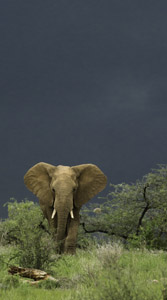
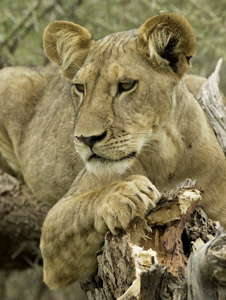

We have over 25 years experience in East Africa, we visit the three best and most diverse locations for photographers, and we tailor the trip for photographers. We discourage casual tourists from joining us unless they know what they're getting into (so continue reading the brochure). We strive for quality photography that not only includes great portraits but, more importantly, great behavior, too, and to photograph action or behavior one must have patience. You will shoot a complete portfolio of African wildlife, but hopefully your images will be a cut above the rest in also including images of wildlife in action, actually doing something! We are the only operators who visit three different locations in the Masai Mara, which provides far more chances for encountering lion or cheetah cubs, gnu river crossings, and a broader range of species.
What we have to offer that is so Unique
My wife, Mary Ann, and I have been leading Photo Safaris to Kenya
and to many other locations in Africa for over twenty-eight years. We were the first to:
institute using radios for vehicle-to-vehicle communication,
the first to offer just three photographers per vehicle,
and the first to fine-tune an itinerary that is now copied by most photo safari.
More importantly, WE KNOW AFRICA, we know how to photograph it,
what to look for, and how to get the best a situation has to offer, both for ourselves and,
most importantly, for the participants that travel with us.
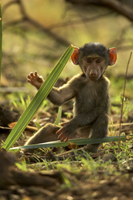 If you look at any of the Trip Reports, you'll get a great idea about our safaris, perhaps even more than what is in this brochure. I cannot stress enough how important experience is when leading a photo safari. We know what to look for, what to listen for, and what to expect, and this translates into imagery that is not simply a matter of luck.
If you look at any of the Trip Reports, you'll get a great idea about our safaris, perhaps even more than what is in this brochure. I cannot stress enough how important experience is when leading a photo safari. We know what to look for, what to listen for, and what to expect, and this translates into imagery that is not simply a matter of luck.
The topics addressed below should answer virtually all of your questions,
and I hope you'll take the time to read them.
I'd like to stress again here that our trips may not be for everyone. They are not 'tourist safaris' where the goal is to simply have you check off the different animals. We invest quality time with our subjects, we don't just see and go. Although we might spend hours with some subjects, when the potential warrants it, our participants still end up seeing everything, but they will be seeing wildlife with absolute quality. The Trip Reports will prove those points.
I do not believe anyone can offer you a better safari.
We know Africa, we know how to make a safari run smoothly, and we know the wildlife.
If you are interested in obtaining quality photographs, in seeing wildlife in-depth, in watching behavior, and witnessing truly once-in-a-lifetime wildlife opportunities, then our safaris are for you.
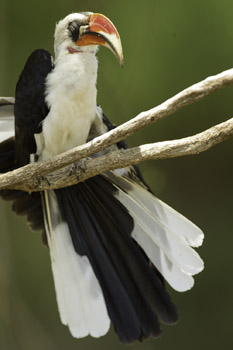
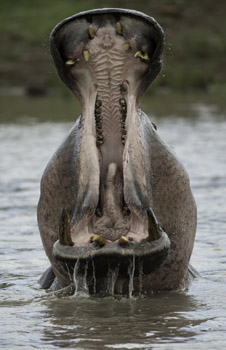
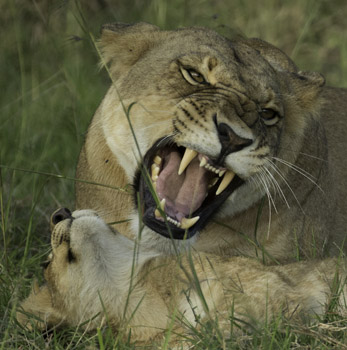
Why do we offer trips in the Fall?
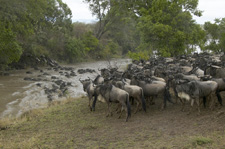 October through early December is one of the slower seasons for tourism in Kenya, except for our safaris and other canny photographers who follow our lead. It is still a most spectacular time of year to visit Kenya, for during this time the wildebeest migration may be 'in', and the short rainy season usually develops sometime during this period, giving us great cloudscapes and skies for some of our shooting.
October through early December is one of the slower seasons for tourism in Kenya, except for our safaris and other canny photographers who follow our lead. It is still a most spectacular time of year to visit Kenya, for during this time the wildebeest migration may be 'in', and the short rainy season usually develops sometime during this period, giving us great cloudscapes and skies for some of our shooting.
If the migration arrives, the bountiful supply of food often stimulates the predators into initiating a mating. Not being far-sighted, lions revel in the abundance of food present at the time, even though the herd may be gone by the time any young are born. Typically, the months following the migration is the time of lion babies, even though this season can be one of extreme stress, as the huge herds of easy game are gone.
 Traditionally, in the 'old days,' the wildebeest migration arrived in the Masai Mara in July, and remained only until September. Whether it is global warming and a disruption in the normal rain cycle or factors we cannot understand or predict, mow-a-days the migration can occur at any time, and over the last several years virtually every one of our safaris has experienced at least one river crossing. One should certainly not base their taking a trip on the 'migration' alone, for a river crossing, while dramatic and exciting, may not yield the types of photography one might expect from seeing nature films. Crocodile kills are indeed rare, as the crocs feed most heavily when the first herds cross the Mara River. Later in the season kills are sporadic. Of course, other predators often lurk in the riverside vegetation to make kills, and it's possible to see, and film, both leopards and lions taking down wildebeest as they make a crossing.
Traditionally, in the 'old days,' the wildebeest migration arrived in the Masai Mara in July, and remained only until September. Whether it is global warming and a disruption in the normal rain cycle or factors we cannot understand or predict, mow-a-days the migration can occur at any time, and over the last several years virtually every one of our safaris has experienced at least one river crossing. One should certainly not base their taking a trip on the 'migration' alone, for a river crossing, while dramatic and exciting, may not yield the types of photography one might expect from seeing nature films. Crocodile kills are indeed rare, as the crocs feed most heavily when the first herds cross the Mara River. Later in the season kills are sporadic. Of course, other predators often lurk in the riverside vegetation to make kills, and it's possible to see, and film, both leopards and lions taking down wildebeest as they make a crossing.
One thinks of the migration in terms of these river crossings, but the migration phenomenon encompasses the entire spectacle - herds grazing across the plains in huge scattered groups, moving in long lines that may extend for miles, and, of course, crossing the rivers too. Herds do not have to cross a dangerous river to enter into the Masai Mara from Tanzania, and many come up and return south without ever having done so. So the migration is just one aspect of the trip.
Our autumn trips usually coincide with the short rainy season - either in the middle of it, or catching either the front or back end. Why travel to Kenya if it's raining? 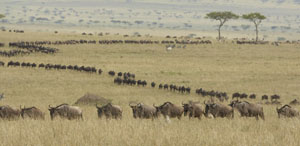 Well, for one, the rains are short - typically they occur in the late afternoon, and they are scattered. It's entirely possible to do a game drive and have rain clouds visible at all four compass points, and yet be rainless. Rains are usually short, too, and rarely compromise a game drive.
Well, for one, the rains are short - typically they occur in the late afternoon, and they are scattered. It's entirely possible to do a game drive and have rain clouds visible at all four compass points, and yet be rainless. Rains are usually short, too, and rarely compromise a game drive.
However, rains generate action! The skies in the afternoon are often magnificent, as thunderheads build up into dramatic skyscapes. Landscape images are far more interesting with a great sky. Rain induces bird nesting activity, and weavers, social weavers, and hornbills actively nest when mud or new grasses are available.
Typically, mornings begin cloud free and brilliant, with clouds building during the day. This provides photographers with the opportunity to shoot subjects in two lighting conditions - in bright light in the AM, and, perhaps, overcast conditions in the afternoon. As one would expect, along the equator the heat builds up through the day and, on a cloudless day, it can get rather warm by late afternoon. Clouds cool things off, so nocturnal animals, like leopards, are much more likely to be active on a cool day than on a hot, sunny afternoon. Another perk for this season!
 We'll be visiting three locations on this safari. Samburu, in the arid, semi-desert area of north central Kenya, Lake Nakuru, mid-way on our journey from one reserve to the other, and the Masai Mara along Kenya's southwestern border.
We'll be visiting three locations on this safari. Samburu, in the arid, semi-desert area of north central Kenya, Lake Nakuru, mid-way on our journey from one reserve to the other, and the Masai Mara along Kenya's southwestern border.
Samburu at this time of year should be filled with bird life. The short rains should have some influence on the landscape and with luck the vegetation will be morphing from dry season brown to verdant short-rain green. Bird activity can be one of your trip highlights here! Of course, the usual wildlife - elephants, the herd animals and ungulates, and the predators will be in their normal numbers, but the bird life can be outstanding.
It is too long a drive to travel from Samburu to the Mara in a single day. We'll be overnighting at Lake Nakuru, arriving in time for a late lunch. After lunch we'll do an afternoon game drive, and another all-morning game drive where we'll concentrate on the incredible flamingos.
Once in the Mara we will spend several days at Sarova Lodge, Mara Serena, and at Mara Intrepids, traveling to each new camp as part of our morning game drives. By basing ourselves at several different locations in the Mara, we will enjoy the maximum amount of time at all three of the hottest areas for lion and hyena activity, as well as plenty of time in prime areas for cheetahs, leopards, elephants, antelope and the resident ungulates. Unlike any other safari, you will see all three main parts of the Mara and experience the magic that each area provides to photographers and naturalists alike.
Of course, while our trips are timed to coincide with the short rainy season, the rains, like anything in nature, are never guaranteed. Regardless, however, the fall and the lack of crowds makes this season our absolute favorite for photographing in Kenya.
To sum up, our focus of this trip will include the following:
Bird life in Samburu - One of the most surprising aspects to many safari photographers is the amount and variety of bird life available, and how much fun photographing the birds can be. Samburu is the premiere bird location, with a large variety of birds of prey, as well as diverse other birds, including owls, ground-dwelling birds, colorful bee-eaters and kingfishers. Many of the tracks run through vegetation that is no higher than our vehicles' roofs, so eye-level shooting is easy.
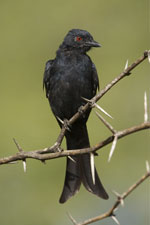
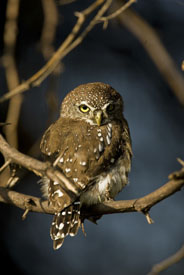
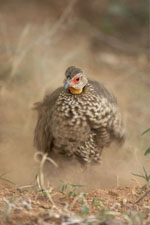

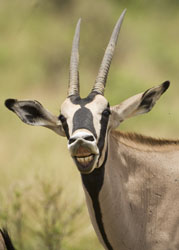
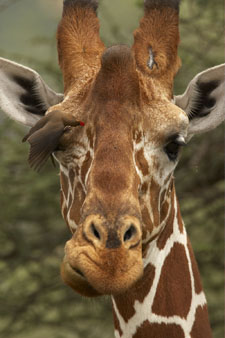
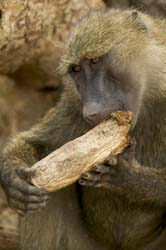

Mammals in Samburu - The elephant action in Samburu can be outstanding.
Several endemic mammals are found nowhere else (see our itenerary), including the upright-standing gerenuk,
the tiny dik-dik, the unicorn-like oryx, and the reticulated giraffe.
We'll have one of our best chances of photographing a leopard here.


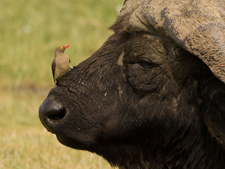
Birds and Mammals in Nakuru - although we'll only be spending a short period of time here, we'll have
ample opportunity for photographing flamingos (should water levels permit), and other birds. Additonally, Lake Nakuru is great for White Rhinos, African Buffalo, and much of the plains game.
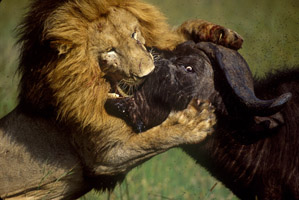
Predatory Action in the Mara - Lions and Cheetahs are likely to be hunting, and if there is any
possibility of photographing incredible action, we will do it.
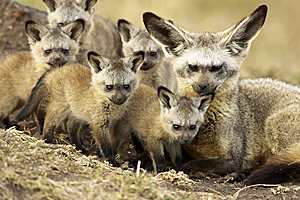
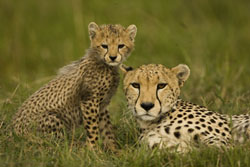
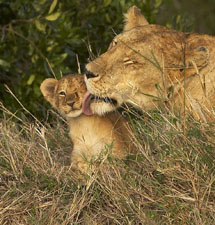
Baby Predators in the Mara - We usually get lion cubs and cheetah cubs. One of the true advantages to our safaris, and this is truly unique, is our staying at three different, widely spaced lodges in the Masai Mara. By doing so, we can cover virtually the entire area, which is simply not possible if you are based at only one location, as most safaris are. In this way, we have the best chance of finding and photographing these appealing babies!

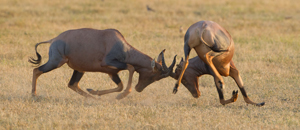
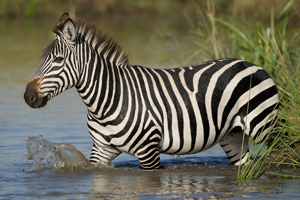
The Usual Stars - of course, we'll also be photographing all the mammals we normally encounter, which include leopards, cheetahs, elephants, hyenas, the hoofed animals, and the birds in Nakuru, the Mara, and Samburu.


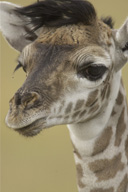
Read on for a more thorough description of the three main areas of shooting.
Featuring the Three Best Photographic Locations in Kenya
There is no place in the world like Kenya. A country about the size of Texas it preserves some of the greatest wildlife concentrations in the world. Just as importantly, however, Kenya is probably the best African country for affordable game viewing and wildlife photography. Kenya is a comfortable, safe country, where the wildlife is accustomed to people and to a close approach by vehicles.
Many safaris attempt to see too much in a very limited period of time. Consider this: If you've ever driven through Texas you know how large a state it is. Could you imagine trying to cover that state, photographically, in just 14 days afield? It couldn't be done, unless you limited yourself to just a few key representative locales.
The same holds true for Kenya. It's impossible to do a quality shoot where five to seven different parks are visited on a two or three week trip. Doing so would limit you to only a day or two per park, and most of your time would be spent in traveling. WE WON'T BE DOING THAT! Instead, we'll concentrate our time at the two best national parks and reserves for photography, which represents two very diverse regions. Doing so we'll have the luxury of time, being able to spend a number of days at each location, and of seeking out specific subjects, rather than simply contenting ourselves with what luck may provide.
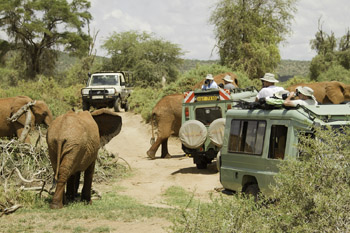

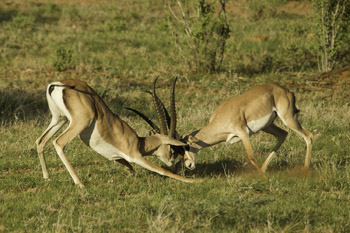
Samburu Game Reserve's semi-desert habitat hosts unique species to the country, including reticulated giraffe, distinguished by a net-like pattern; gerenuk, giraffe-like antelope that feed while standing on their hind legs; Grevy's zebra, with thin stripes and a white belly; Beisa oryx, huge antelopes with long, straight horns that may have originated the unicorn legend; and a variety of birds. Samburu affords the best chances at filming pale-chanting goshawks, hornbills, vulturine guineafowl, yellow-throated spurfowl, and dozens of other species. Samburu is also an excellent location for leopard: we don't always get them there (5 of 6 safaris we lead usually do) but the leopards we get are usually excellent for filming (my Feb. '90 Natural History Magazine cover was taken at Samburu and Mary's BBC winning leopard in '98).
 Lake Nakuru supports one of the largest populations of lesser flamingos in the world, and in good years there are, quite literally, millions of birds along the shorelines. Nakuru is also quite good for leopard, and sometimes great Lions. Nakuru offers other great subjects that you are quite likely to film very well, including African buffalo, DeFassa waterbuck, impala, warthog, reedbuck, Rothschild giraffe, and olive baboon.
Lake Nakuru supports one of the largest populations of lesser flamingos in the world, and in good years there are, quite literally, millions of birds along the shorelines. Nakuru is also quite good for leopard, and sometimes great Lions. Nakuru offers other great subjects that you are quite likely to film very well, including African buffalo, DeFassa waterbuck, impala, warthog, reedbuck, Rothschild giraffe, and olive baboon.
If our trip ended after Samburu and Nakuru you'd have had a fantastic experience. However, the Masai Mara Game Reserve is the 'dessert,' and is viewed by many as the premier wildlife photography location in Africa. This great game location will be our last stop on our photographic adventure.
 The Masai Mara is considered part of the famous Serengeti ecosystem, but differs in offering a variety of habitats. Within a morning's game drive one can film short grass high country, tall grass prairie, riverine forests and thickets, and acacia thorn scrubland. Elephants, hippos, Masai giraffe, common zebra, gnu, impala, Thompson's and Grant's gazelles, topi, hartebeest, hyrax, black-backed jackal, spotted hyena, cheetah, leopard, and lion are permanent, and fairly common, residents within the park. There's also several less common species of antelope, including reedbuck, bushbuck, steinbuck, oribi, and duiker, that we normally encounter.
The Masai Mara is considered part of the famous Serengeti ecosystem, but differs in offering a variety of habitats. Within a morning's game drive one can film short grass high country, tall grass prairie, riverine forests and thickets, and acacia thorn scrubland. Elephants, hippos, Masai giraffe, common zebra, gnu, impala, Thompson's and Grant's gazelles, topi, hartebeest, hyrax, black-backed jackal, spotted hyena, cheetah, leopard, and lion are permanent, and fairly common, residents within the park. There's also several less common species of antelope, including reedbuck, bushbuck, steinbuck, oribi, and duiker, that we normally encounter.
The very endangered black rhino has made its last stand in the Mara here. We've had luck on many of our trips finding rhinos with calves, and we'll hope to do so again this year. Additionally, serval (a small spotted cat) are most easily found here, and in the scattered acacia trees leopards hang their carcasses out of reach of the many lions. Consequently, it's easiest to find tree-climbing leopards here.
The Mara, however, is diverse, and it is impossible to do the Park justice by basing out of only one lodge. To cover the park thoroughly we'll be based out of three different lodges. In the extreme south we'll stay at Mara Sarova, covering the area from the Talek and Sekanani gates southward to the border of Tanzania and the Serengeti National Park. We'll stay at Mara Serena Lodge, covering the Mara Triangle and southwestern corner; and in the northern section we'll stay at Mara Intrepids, covering the area from the Musiara Marsh to the Talek River including Rhino Ridge and Paradise Plains.
The very endangered black rhino has made its last stand in the Mara here and we have a great chance of photographing one amidst the croton bush thickets. In the absence of Maasai persecution, the lions and hyenas are active during the day.
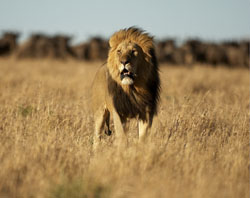


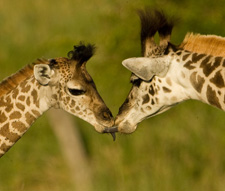
Who Is This Safari For?
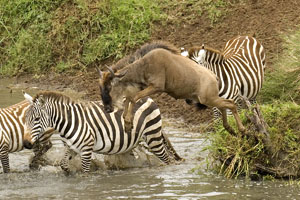 This safari is really for anyone who is serious, either about wildlife and nature photography, or about in-depth, intense, and patient animal viewing. The two, for a photographer, are the same, for patience, time, and luck are required in order to obtain great wildlife images. Please read the following section carefully. While almost everyone who travels with us are like-minded, there are, on occasion, one or two people who are not. This is not a safari for tourists. This is a safari for photographers - serious amateurs or photo enthusiasts or pros, and for those who really want to do a safari right.
This safari is really for anyone who is serious, either about wildlife and nature photography, or about in-depth, intense, and patient animal viewing. The two, for a photographer, are the same, for patience, time, and luck are required in order to obtain great wildlife images. Please read the following section carefully. While almost everyone who travels with us are like-minded, there are, on occasion, one or two people who are not. This is not a safari for tourists. This is a safari for photographers - serious amateurs or photo enthusiasts or pros, and for those who really want to do a safari right.
 Actually, it really doesn't matter to us if you bring a camera or not, or if you do not have long telephoto lenses or professional gear along. That is, provided you are patient, willing to wait, and, above all, considerate to those photographers who do have gear that requires a rock-steady vehicle when they're about to shoot. Patience, to a wildlife photographer, is NOT a relative term. Patience may not be a five-minute wait. It may mean waiting an hour before a cheetah and her cubs decide to move from a croton thicket, or before a den full of hyena cubs wake up and begin to play. We have literally waited for four or five hours for a wildebeest river crossing. Photographers, avid naturalists, artists, and others who are serious about wildlife have no problem with this. You might.
Actually, it really doesn't matter to us if you bring a camera or not, or if you do not have long telephoto lenses or professional gear along. That is, provided you are patient, willing to wait, and, above all, considerate to those photographers who do have gear that requires a rock-steady vehicle when they're about to shoot. Patience, to a wildlife photographer, is NOT a relative term. Patience may not be a five-minute wait. It may mean waiting an hour before a cheetah and her cubs decide to move from a croton thicket, or before a den full of hyena cubs wake up and begin to play. We have literally waited for four or five hours for a wildebeest river crossing. Photographers, avid naturalists, artists, and others who are serious about wildlife have no problem with this. You might.
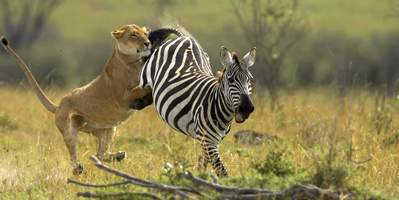 We want to make this clear. Great shots often require patience. If you simply want to see animals, click off a few pictures, and move on to another subject, then our safari is not for you. You might worry that 'spending time' waiting is wasteful, and that your time would be better spent roaming and looking for new subjects. Let me assure you that in the course of a two-week trip you will indeed see everything, but some subjects, that require waiting will reward you with extraordinary images for your patience. In other words, you'll see everything the normal tourist sees (or the impatient photographer), but you'll also see, with quality, other subjects, events, or activities that most simply do not see because they do not have the patience to wait. We do.
We want to make this clear. Great shots often require patience. If you simply want to see animals, click off a few pictures, and move on to another subject, then our safari is not for you. You might worry that 'spending time' waiting is wasteful, and that your time would be better spent roaming and looking for new subjects. Let me assure you that in the course of a two-week trip you will indeed see everything, but some subjects, that require waiting will reward you with extraordinary images for your patience. In other words, you'll see everything the normal tourist sees (or the impatient photographer), but you'll also see, with quality, other subjects, events, or activities that most simply do not see because they do not have the patience to wait. We do.
 For example, even our extremely experienced Kenya safari driver/guides have seen things with us that they have never seen before - and these are guides who, collectively, have over forty years driving experience. This has included such experiences as a zebra stallion killing a foal; a zebra giving birth; lions killing a bull buffalo; elephants, en masse, wrestling in the river; a leopard killing a wildebeest, or a warthog; ostriches hatching from eggs; lions pulling a warthog from its den; and much, much more. Why? I asked our driver/guides this, and they said, 'because your groups stay and watch. Most groups do not, and only spend enough time to make some pictures.' They miss these unique events, and so, obviously, had the driver/guides.
For example, even our extremely experienced Kenya safari driver/guides have seen things with us that they have never seen before - and these are guides who, collectively, have over forty years driving experience. This has included such experiences as a zebra stallion killing a foal; a zebra giving birth; lions killing a bull buffalo; elephants, en masse, wrestling in the river; a leopard killing a wildebeest, or a warthog; ostriches hatching from eggs; lions pulling a warthog from its den; and much, much more. Why? I asked our driver/guides this, and they said, 'because your groups stay and watch. Most groups do not, and only spend enough time to make some pictures.' They miss these unique events, and so, obviously, had the driver/guides.
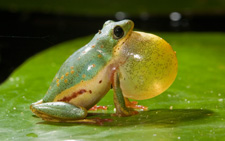 That said, we are not tyrants . We realize everyone has their own patience and frustration level, and perhaps their own desire to shoot particular subjects. One of the values of traveling with us is we can guide you, by stating our belief whether we feel something is worth waiting for, or not. Our rule is this: If you don't wish to stay, you can leave, provided everyone in your vehicle agrees on this, or if at least three in total from all of the vehicles agree to leave, whereupon we'll rearrange seating to allow those people to return to camp or continue on their way. We have, on many occasions, put three or four people into a van to head back to camp for lunch while the die-hards stayed behind, waiting for the cheetah to make its kill or for the wildebeest to cross the Mara river. In most instances, the cheetah killed, and the wildebeest crossed, right after the other van left!
That said, we are not tyrants . We realize everyone has their own patience and frustration level, and perhaps their own desire to shoot particular subjects. One of the values of traveling with us is we can guide you, by stating our belief whether we feel something is worth waiting for, or not. Our rule is this: If you don't wish to stay, you can leave, provided everyone in your vehicle agrees on this, or if at least three in total from all of the vehicles agree to leave, whereupon we'll rearrange seating to allow those people to return to camp or continue on their way. We have, on many occasions, put three or four people into a van to head back to camp for lunch while the die-hards stayed behind, waiting for the cheetah to make its kill or for the wildebeest to cross the Mara river. In most instances, the cheetah killed, and the wildebeest crossed, right after the other van left!
Non-Photographers, Artists, and Videographers - Please Note
As I've already stated, photographers will get the most out of this trip, rather than the average tourist. Non-photographers might feel frustrated in not being able to produce images that others can; but that thought alone may be motivation for you to buy a telephoto lens and camera before doing the trip. I'd recommend doing so. Artists can benefit from our type of safari as well. If we're waiting for cheetahs to hunt, or for lions to resume mating, there's usually time to do field sketches or character studies. However, if you are an artist, don't be upset if your vehicle moves while you're still drawing! This is, FIRST AND FOREMOST, a photography trip, and the photographers have the final say. This also applies to people doing video. Still photography is all about 'the shot' and not screen continuity where an animal walks off to finish a video sequence. While that's happening, for a video shooter, a still photographer might be missing dozens of great shots if the vehicle had only followed. Consequently, our driver/guides and our photographers know that we will move to get the shots. Some video photographers may be frustrated by this, but the goals of a serious video photographer and a serious still photographer may be at odds, and this is a photography trip.
Our Unique and Fair Rotation System
We do not assign people to one vehicle for the entire trip. Instead, we rotate everyone through our vehicles so that everyone has a chance to shoot with each other (avoiding trip-damaging cliques) and to shoot with both Mary and me.
Our rotation system gives everyone equal time with Mary and with me, and as we 'captain' our respective vans you can be assured that we'll do our best to put you in the best shooting situation as we read the light, determine animal behavior, or just simply look after you for the shots you're seeking but have not yet achieved.
Make no mistake: Mary and I are here to work. I joke that when you're with me you'll get the best photos, and Mary says the same thing. But the fact is, you will probably get your best shots on those occasions with either of us, on average. But the point is, we're not going through the motions here. We're out to make the best photographs we can, and you'll get those same images when you're with us. That's not to say that when you're not with us you won't do well -- this isn't a zoo, and you might see something that we don't, but what we are saying is we're always trying to make the best images for our clients and for ourselves.
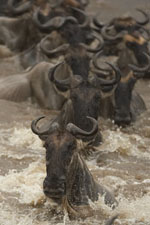
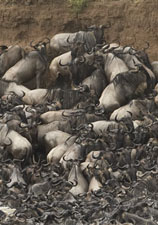
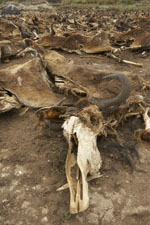
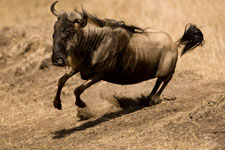
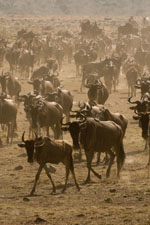
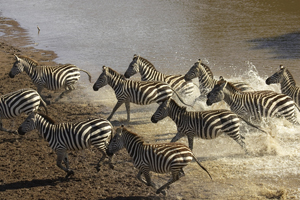
Consider this, too. Mary and I have seen scores of wildebeest river crossings, and dozens of cheetah kills.
In truth, we probably have our best river crossing shots already in file. But YOU DON'T, and we realize this, and that's why we urge you to be patient, to wait, and to see the wonderful things that we have already seen. But we also know that each kill is different, each river crossing is different, and that any event in nature has the absolute potential of unfolding into the greatest spectacle we've ever seen. So, remember, when you are in our care, we are looking out for you, we're trying to get you the best shots possible, and we are willing to put in the time for these events to occur. You should be, too.
Are you willing to eat a modest picnic breakfast afield rather than return to camp for a big cooked breakfast? If you answer this question with a Yes, then this trip will be for you and you'll fit in with the type of gung-ho photographer we attract. Are you willing to eat the leftovers from breakfast, or your 'emergency' Granola bars, for lunch instead of returning to camp to eat a cooked lunch if the shooting requires this? On an average we generally miss ONE lunch because of a hunting cheetah.
Regarding breakfasts, we always eat a picnic breakfast in Samburu and the Masai Mara. It doesn't make sense to return from the field while the light is still great just to eat. Instead, whenever we have a lull in activity, we park our vehicles and grab breakfast then. As stated above, normally we do not stay out all day, although if something is very good, or promising, we will. That means that sometimes we'll miss lunch (or we'll come in for a very late lunch), and for that reason we advise people to pack candy or granola bars for a quick snack. We usually do return for lunch, however, since at high noon the light is high and extremely contrasty and almost all animal activity ceases in the hottest hours. However, if you're concerned about eating the meals you paid for, and of sleeping in when you wish, then I don't think our trips will be for you. With us, photography comes first. Especially with the heat of Samburu, we're usually in by 11:30AM, although on cloudy days, or when there was extraordinary action, we've come in closer to 1PM.
Our personal safaris with three per nine passenger vehicle are radically different from the typical 15-20 person safari crammed with five to nine passengers to a van or a tour 'limited' to twenty or more people. For that reason this safari is naturally more expensive, but in reality it's not that much more. Please, just ask yourself what your objective is:
Is it to see Kenya and to take snapshots, or to be on a special photo safari designed to provide the best shooting opportunities possible. If your answer is the latter, then this safari is for you.
What You Can Expect from Us
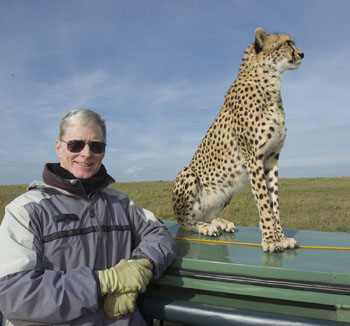 From Kenya you can expect the best, most exciting wildlife photography possible on this planet. I liken Kenya to doing a shoot combining the best of three great US destinations -- Denali, Yellowstone, and the Everglades, for there are large mammals, birds, and scenics, all possible in one locale the size of Texas, and we'll be concentrating on one very small portion of that area.
From Kenya you can expect the best, most exciting wildlife photography possible on this planet. I liken Kenya to doing a shoot combining the best of three great US destinations -- Denali, Yellowstone, and the Everglades, for there are large mammals, birds, and scenics, all possible in one locale the size of Texas, and we'll be concentrating on one very small portion of that area.
We will prepare you photographically. I've written a shooting guide to Kenya that you can use as a handbook or reference when considering composition and exposure for most of your shooting subjects. Prior to the trip we'll provide you with our own recommendations on the gear to bring and, on safari, we'll provide thorough briefings on the subjects we expect to film and how to do so. We have a video as well, that describes the camps, the food, the shooting arrangements with the vehicles, and also provides important information on the natural history of most of the subjects you'll see, as well as our photographic tips for these subjects. You can order the video directly from our office.
Finally, in the field you'll be with either Mary or myself on an average of two out of every three game drives. As I mentioned earlier, we'll do our best to get you the best shots possible, and we'll be able to provide you with our suggestions on composition and exposure and, perhaps most importantly, on what we expect to happen and where we should be. Knowing animal behavior is a real plus, if not a key to successful wildlife shooting, and our experience, and that of our fantastic Kenyan driver/guides, will insure we have the best chance at obtaining great images.
Hopefully, too, you can expect great images of:
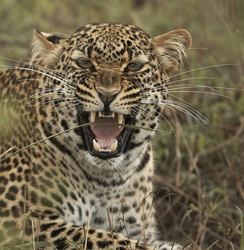 The Leopard: Leopards are elusive, solitary creatures. Surprisingly common, they are difficult to see, well-camouflaged, shy, and retiring. They are the trophy of any safari, and the hardest cat to film. I've never missed with leopard, in FIFTY trips, but I'm always worried, and we work hard to get this cat!
The Leopard: Leopards are elusive, solitary creatures. Surprisingly common, they are difficult to see, well-camouflaged, shy, and retiring. They are the trophy of any safari, and the hardest cat to film. I've never missed with leopard, in FIFTY trips, but I'm always worried, and we work hard to get this cat!
The Cheetah: Spotted, elegant, and surprisingly tame, this cat of the open grasslands is the easiest to film, once encountered. We'll spend approximately half the trip in the best locale in Kenya (the Masai Mara) for cheetahs, and we'll have an excellent chance of filming this, the fastest land animal in the world. Filming it hunting, however, will require luck and patience, although we should have the opportunity to do exactly that. Hunting cheetahs require patience, and this is the day we often miss lunch.
The Lion: The king of beasts appears to be anything but as it sleeps beneath an acacia. Stare into a male's eyes, or watch one snarl, or half-rise as if to charge, and you'll quickly understand how and why the lion got its title. Lions are easy to see, and in the Mara they can be surprisingly common. Photographing lions in action, however, is quite different from the sleepy views most tourists see. We'll be out early to catch any dawn hunts, and staying with a pride if hunting activity looks promising.
Black Rhinos: We may have an opportunity to photograph this endangered species in the Mara, and at two of our lodges we'll be in prime rhino country. We're usually very successful! We'll also have a good chance for black rhinos, and an excellent chance for white rhinos, when we are at Lake Nakuru.
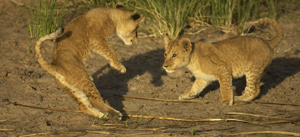


Elephants: Both Samburu and the Masai Mara have very healthy elephant populations. Depending upon the rains, elephants may put on a great show in Samburu, or be absent. In the Mara, elephants are common and easy to find; and make for wonderful, animated subjects.
Lesser Predators and the Herbivores: Typically, we also have great luck with hyenas, black-backed jackals, side-striped jackals, serval cats, and bat-eared foxes. We usually photograph three different primates - olive baboons, vervet monkeys, and colobus monkeys, and virtually all the herbivores - elephants, buffalo, zebras, antelope, hippos, warthog, etc. We typically have luck with some of the less common species, too, like greater kudu, steinbok, oribi, and klipspringer, but these, among the antelopes, are the real trophies and are not a 'given.'
Why we have such great success...

We'll have a wide variety of animals and birds available at our three destinations. With radios in each of the vehicles our groups can game drive independently, but can meet whenever a great subject is spotted. Unlike many other tours our vehicles often game drive separately, fanning out to cover the largest area possible. In this way, when one of our vehicles spots a leopard, or cheetah, or baby elephant, or similarly great subject, everyone has the opportunity to photograph that subject, too.
We are also the only safari operators who rotate our participants in a fair basis throughout all the vehicles so that you see and work with all the driver/guides, the other participants, and with Mary and I. Our rotation -- done for both morning and afternoon game drives -- insures that you see Mary and I an equal number of times (we feel that you will get your best shots when you are with us, an ego thing, sure, but we know what we're doing!), an equal number of times with the various driver/guides, and as diverse a rotation as can be accomplished in being with the other participants on the trip. In this way our groups become tightly knit into one big happy family.!
Our Itinerary
 As this itinerary is planned nearly a year in advance, there's always the possibility of slight changes -- in day rooms, flight times, etc. However, the actual field time is almost never affected by last-minute airline or hotel changes.
As this itinerary is planned nearly a year in advance, there's always the possibility of slight changes -- in day rooms, flight times, etc. However, the actual field time is almost never affected by last-minute airline or hotel changes.
Day 1, Arrive in Nairobi in the late evening or early hours of Day 2. Overnight: Nairobi Serena Hotel, Nairobi.
Day 2, We'll depart around 9:30AM for our drive to Samburu Game Reserve, arriving in time for a very short (non-photographic) game drive as we drive to our lodge. Overnight: Elephant Bedroom Camp.
Elephant Bedroom Camp is a beautiful introduction to our safari experience, with only 12 luxury tents situated in the heart of elephant country. The staff and the food and the accommodations are incredible, and we couldn't imagine a better place to start our photo safari.
 Day 3-5, Samburu Game Reserve. Over the next three days we'll concentrate upon the wildlife, birds, and scenery that characterize one of Kenya's prettiest parks. Along the river we'll seek elephants coming to drink and play, crocodiles lying in wait for prey, and monkeys using the riverine forest for shelter. Samburu may offer us leopard (it usually does), our best close-up opportunities for bird photography, and unusual endemic mammals, including oryx, gerenuk, dik-dik, reticulated giraffe, and Grevy's zebra. By the end ofour third day we should have everything captured on film, ready to press on to our next destination.
Day 3-5, Samburu Game Reserve. Over the next three days we'll concentrate upon the wildlife, birds, and scenery that characterize one of Kenya's prettiest parks. Along the river we'll seek elephants coming to drink and play, crocodiles lying in wait for prey, and monkeys using the riverine forest for shelter. Samburu may offer us leopard (it usually does), our best close-up opportunities for bird photography, and unusual endemic mammals, including oryx, gerenuk, dik-dik, reticulated giraffe, and Grevy's zebra. By the end ofour third day we should have everything captured on film, ready to press on to our next destination.
Overnights, Elephant Bedroom Camp.
Day 6, Samburu to Lake Nakuru. We'll leave Samburu, early, for our next destination, Lake Nakuru. We'll arrive in time for a late lunch. After lunch we will do a late afternoon game drive where we may film African white pelicans, flamingos, and White Rhinos, the only location where we will have this species. Leopards, and even tree-climbing lions, can be seen in the yellow-barked acacia forests.
Overnight, Lion Hill Lodge.


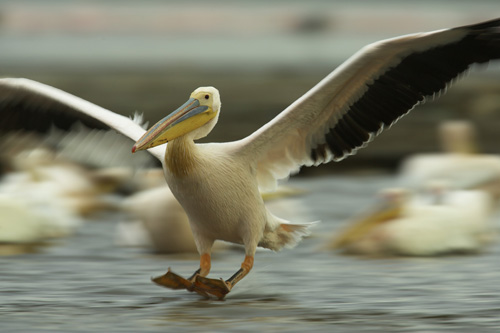 Day 7, Lake Nakuru to the lower Masai Mara. After an early breakfast we'll do a morning game drive where we'll work on white rhinos, lesser flamingos, and whatever other species we encounter. Nakuru hosts black rhinos, too, and we sometimes get both on a single game drive. Additionally, there are several species of plains game we'll also see in the Mara, including Thompson gazelle, warthog, Defassa waterbuck, and common zebra. Nakuru has an endangered subspecies of giraffe, the Rothschild giraffe, and we're fairly likely to see and photograph this species. We'll leave the park in late morning and head to our final shooting destination, the Masai Mara. En route we'll stop for lunch before continuing to the southern end of the Masai Mara arriving right before sunset. The Mara is Maasai country. The grass grows high, and lions are common and active during the daylight hours.
Day 7, Lake Nakuru to the lower Masai Mara. After an early breakfast we'll do a morning game drive where we'll work on white rhinos, lesser flamingos, and whatever other species we encounter. Nakuru hosts black rhinos, too, and we sometimes get both on a single game drive. Additionally, there are several species of plains game we'll also see in the Mara, including Thompson gazelle, warthog, Defassa waterbuck, and common zebra. Nakuru has an endangered subspecies of giraffe, the Rothschild giraffe, and we're fairly likely to see and photograph this species. We'll leave the park in late morning and head to our final shooting destination, the Masai Mara. En route we'll stop for lunch before continuing to the southern end of the Masai Mara arriving right before sunset. The Mara is Maasai country. The grass grows high, and lions are common and active during the daylight hours.
Overnight, Mara Sarova Lodge.
 Day 8-9, Lower Mara. From our base in the southern Mara we'll concentrate on the wildlife unique to the area. There are a number of black rhinos in this section of the Masai Mara and we'll have a good chance of filming one here. Elephants are common, as are Masai giraffe, hartebeest, and topis. Here we'll have our best chances at filming lions in action, be that mating, hunting, feeding, and hopefully even making a kill. Hyenas are common, too, and with the absence of easy prey these scavenger/hunters should be quite active during the day. Always on the alert for an easy meal, hyenas are more likely to be filmed at a carcass during the day in the southern Mara than anywhere else in Kenya.
Day 8-9, Lower Mara. From our base in the southern Mara we'll concentrate on the wildlife unique to the area. There are a number of black rhinos in this section of the Masai Mara and we'll have a good chance of filming one here. Elephants are common, as are Masai giraffe, hartebeest, and topis. Here we'll have our best chances at filming lions in action, be that mating, hunting, feeding, and hopefully even making a kill. Hyenas are common, too, and with the absence of easy prey these scavenger/hunters should be quite active during the day. Always on the alert for an easy meal, hyenas are more likely to be filmed at a carcass during the day in the southern Mara than anywhere else in Kenya.
Overnights, Mara Sarova.
Day 10, Lower Mara to the Mara Triangle. We'll leave our southern base and do a morning game drive to our second great destination in the Masai Mara, Mara Serena Lodge. And I mean great! Mara Serena is probably the most beautiful lodge in all of Kenya, and the gardens have great songbirds and an exceptionally tame population of bush hyrax. But we're not there for the lodge's beauty! During the fall migration, Mara Serena is located almost directly above one of the premier river-crossing areas for wildebeest and zebras. The area can be extremely productive for lion, cheetah, serval, and black rhino, as well as giant Nile crocodiles, hippos, and elephants. One more word, though, about the lodge. It is beautiful, and the food is outstanding. There are more lights in your room than there probably are in your bedroom at home, so Serena lends itself wonderfully for catching up on battery charging, doing laptop stuff, etc. It's a great place at a great location. Overnight, Mara Serena Lodge.
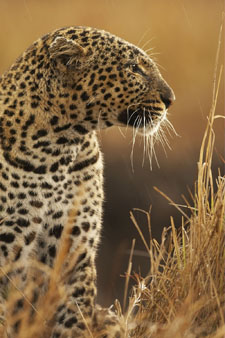 Day 11, Mara Triangle. We'll continue to game drive around the Serena area, working on lions, cheetahs, servals, and everything else. From Serena, we'll have the only opportunity available to game drive through the southwestern corner, often called the Mara Triangle, where, someday, I'm sure African hunting dogs will return. Overnight, Mara Serena.
Day 11, Mara Triangle. We'll continue to game drive around the Serena area, working on lions, cheetahs, servals, and everything else. From Serena, we'll have the only opportunity available to game drive through the southwestern corner, often called the Mara Triangle, where, someday, I'm sure African hunting dogs will return. Overnight, Mara Serena.
Day 12, Mara Triangle to Upper Mara. We'll leave Serena for our morning game drive, visiting the extreme northwestern section of the Mara Triangle (also known as the Trans Mara Conservation Area). This is a great spot for virtually all of the Mara's species, although one, the side-striped jackal, is most commonly seen in this area. At the conclusion of our morning game drive we'll leave the Park, cross the Mara River and travel through what is now Maasai country . We'll re-enter the Park near the Musiara Gate and continue to our final, EXTREMELY PRODUCTIVE, destination. That's the upper middle section of the Mara where we'll base out of Mara Intrepids Camp. After a late lunch and a short break, we'll do our first afternoon game drive in an area that has become our favorite part of the park. Overnight, Mara Intrepids Camp.
If Mary and I had only place to visit in Kenya it would be to the Upper Mara and the Mara Intrepids Camp. It is our favorite lodge and our favorite location. This tented camp is probably the least fancy of all the places we visit, but for a variety of reasons, including the fact that it 'feels' most like Africa, we love it.
 Day 13-14, Upper Mara. Although all of the Mara is rich, and the Mara Intrepids area is truly exceptional. Leopards are particularly common here. There's a great lion pride here as well, with 3 males that must rank among the most spectacular in the entire Mara. Intrepids is situated along the Talek River, and many of our game drives follow the serpentine route of the often-dry river. Because of the frequency of game drives along the river wildlife is exceptionally tame, and we've had some of our best bird of prey photography along this river including good opportunities for African fish eagles, Bateleur eagles, and kites. Intrepids' wonderful assortment of spectacular game is a fitting ending to our safari - offering the potential of some truly exciting photography. Overnights, Intrepids.
Day 13-14, Upper Mara. Although all of the Mara is rich, and the Mara Intrepids area is truly exceptional. Leopards are particularly common here. There's a great lion pride here as well, with 3 males that must rank among the most spectacular in the entire Mara. Intrepids is situated along the Talek River, and many of our game drives follow the serpentine route of the often-dry river. Because of the frequency of game drives along the river wildlife is exceptionally tame, and we've had some of our best bird of prey photography along this river including good opportunities for African fish eagles, Bateleur eagles, and kites. Intrepids' wonderful assortment of spectacular game is a fitting ending to our safari - offering the potential of some truly exciting photography. Overnights, Intrepids.
Day 15, Upper Mara to Nairobi to home. We'll have a cooked breakfast before boarding our Air Kenya flight to return to Nairobi. On your flight you'll be passing over some of the country we game drove across, providing a new perspective to your trip. You'll have the afternoon free to pack and rest, before enjoying your final, farewell dinner . The tour formally ends at the conclusion of this evening meal, with most participants taking that evening's flight home (most international departures are at night), with arrival in the US sometime on the following day after a change of planes in Europe. Day room, the Nairobi Serena Hotel.
What's Included
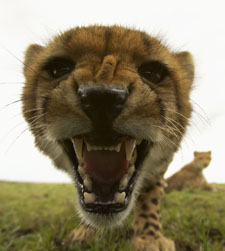 The photo safari prices for our trips is based on land costs from Nairobi and includes all accommodations (double occupancy), all meals except lunch in Nairobi, park entrance fees, and ground transportation, including our exclusive three photographers per vehicles. A single rooming supplement is available. See prices above.
The photo safari prices for our trips is based on land costs from Nairobi and includes all accommodations (double occupancy), all meals except lunch in Nairobi, park entrance fees, and ground transportation, including our exclusive three photographers per vehicles. A single rooming supplement is available. See prices above.
Surcharge for less than 10 Participants
Our safari price is based upon 10 photography participants, filling the vehicles with three photographers per vehicle. While there is a surcharge if the trip doesn't fill, there is a tremendous advantage for YOU, the participant, as there will only be two photographers in these vehicles. You'll still have the benefits of our expertise when you rotate into our vehicle, but on game drives that you're not with Mary or me you have a good chance of having almost a private vehicle!
Our lodging varies from permanent tented camps to normal tourist lodges. Tented camps are permanent structures, more like a hotel room under canvas, with flush toilet, running water, and shower inside each tent. Excellent cooks prepare food and most meals have a European/British influence. You won't be eating fresh killed zebra or eggs over a campfire! Drinks are not included, but they are inexpensive.
Our price also includes the driver/guide's tip and I know that we provide our guides with one of the very best tips they receive each year. Our driver/guides are the best, experts at animal behavior and, from working with me for years, quite adept at putting us into the best spots for great pictures. I use the same guides each year and they know how I work and what's expected of them. They're great, and we love to reward them well for their efforts.
Special non-photographic Spouse Offer
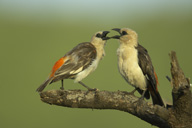 We'll be offering two spots at a discounted price for a spouse to accompany the photographer. This is the deal. The spouse will be seated in the front seat, next to the driver, for all game-drives. This is a comfortable riding position, and will afford great game-watching views and opportunities for all but those times when game is on the right hand side behind the driver. The non-photo spouse is a non-photography position, and the driver/guides will not be positioning a vehicle to accommodate the non-photo spouse, but to work for the photographers. The non-photo spouse will need to sit still during shooting times, and will not be able or allowed to climb into the back with the photographers, regardless of viewing opportunities or lack thereof.
We'll be offering two spots at a discounted price for a spouse to accompany the photographer. This is the deal. The spouse will be seated in the front seat, next to the driver, for all game-drives. This is a comfortable riding position, and will afford great game-watching views and opportunities for all but those times when game is on the right hand side behind the driver. The non-photo spouse is a non-photography position, and the driver/guides will not be positioning a vehicle to accommodate the non-photo spouse, but to work for the photographers. The non-photo spouse will need to sit still during shooting times, and will not be able or allowed to climb into the back with the photographers, regardless of viewing opportunities or lack thereof.
This offer is meant to provide couples an opportunity to travel together and to enjoy Kenya, but with the very real proviso that this does not impact upon the photography or opportunities for the 'shooters.' This is a photography trip and, spouses or not, will remain so. If interested, please inquire for the special discounted price. Further, the  non-photographic spouse is a 'non-voter' in terms of whether a vehicle stays or goes, should it occur that some photographers wish to remain with a subject and others do not. In other words, if your spouse and you (the photographer) wish to leave, but the other two photographers (three photographers per van, remember) do not, it is two for, one against, and the vehicle remains.
non-photographic spouse is a 'non-voter' in terms of whether a vehicle stays or goes, should it occur that some photographers wish to remain with a subject and others do not. In other words, if your spouse and you (the photographer) wish to leave, but the other two photographers (three photographers per van, remember) do not, it is two for, one against, and the vehicle remains.
With this in mind, we always suggest that spouses fill a photography spot even if they do not plan on shooting. Doing so allows that person more freedom of movement -- they can stand or sit, and they will have a better view of game. Non-photo spouses will be required to sign an agreement stating their knowledge of these facts, because a few spouses have, in the past, signed their non-photo spouses up without telling them any of these details, and the non-photo spouses were not happy with that arrangement!
Many non-photographic spouses have spent their time viewing game, sketching, or simply reading when the photographers were poised and waiting for activity. Some non-photo spouses elect to sit out some game drives, and have spent their time walking the grounds or writing, or going on nature walks with lodge personnel.
My Objective
 You should return with the best photographs of wildlife you've ever taken. This doesn't come easily; it requires early starts, patience, and a degree of luck. I believe any photographer traveling to Kenya wants this, and that they're more interested in filming game than they are in lounging at a pool or in having a leisurely cooked breakfast during the best shooting time of the day!
You should return with the best photographs of wildlife you've ever taken. This doesn't come easily; it requires early starts, patience, and a degree of luck. I believe any photographer traveling to Kenya wants this, and that they're more interested in filming game than they are in lounging at a pool or in having a leisurely cooked breakfast during the best shooting time of the day!
Our field days start before dawn so that we can greet the sunrise with our lenses. We'll have modest boxed picnic breakfasts on most field days, since this saves time and allows us to travel anywhere without having to worry about returning for a breakfast. Lunches and dinners are at camp, and, with the quantity of food available, I doubt if you'll miss the cooked breakfast. We may, however, occasionally miss lunch if a subject is so good that to leave it would be silly. That doesn't happen often, and if we decide to do so, we do it by group consensus. I'll tell you, when the vote comes up, when such a situation arises, people always look at me as if I'm crazy for even asking them if they wish to leave! Nonetheless, if at least three people (from x number of vehicles) wish to leave at any time, they are welcome to do so. We will not do so for only two, however. Our rule is three photographers per van, so three is the magic number.
We will stay with a subject as long as it's necessary to get great photos, provided the goal is realistic. Some animals require only a minute of work for a snap-shot like opportunity that still provides a great image. Others require work, and we've stayed with some subjects for hours (or for an entire day). Don't be afraid that by doing this you'll miss other shots. I've done enough of these (this will be my 28th year of doing Kenya safaris) that I know what's good, what's worth our time, and where our priorities should lie and also provide full coverage of everything you wanted to film.
You will amass a wonderful portfolio of all your Kenyan wildlife, but you won't be producing traditional boring tourist shots. We'll try to get you great images -- magic material! Although we won't be consciously amassing a species list, you'll undoubtedly see as many, if not even more, species of wildlife by doing it this way than you would by being a 'tourist,' since we'll be in the field longer, looking, watching, and photographing.
Our Roles as Leaders, and Your Role
 Mary and I know Kenya, its wildlife, and how to photograph it. I want everyone to obtain great photographs, and to enjoy himself or herself while doing so. Great photography requires patience, luck, and time, plus a degree of skill that my drivers/guides and Mary and I can provide. You can trust us that everything we do as your trip leaders will have those priorities - your photos and well-being as an individual in our group -- in mind.
Mary and I know Kenya, its wildlife, and how to photograph it. I want everyone to obtain great photographs, and to enjoy himself or herself while doing so. Great photography requires patience, luck, and time, plus a degree of skill that my drivers/guides and Mary and I can provide. You can trust us that everything we do as your trip leaders will have those priorities - your photos and well-being as an individual in our group -- in mind.
Don't expect me to compromise the group for you, whether that's for tardiness, forgetfulness, or otherwise. We won't. We're upfront about our time, field breakfasts, tenacity and seriousness, and we want our people to know this. If you join us, that's what you're getting into. I think some people join a group and expect it to conform to their individual demands. We won't do that. If you like to travel privately, or to 'run the show,' or to make selfish demands, we'd suggest you go alone.
Honestly, if you're not serious about photographing or you know that you're not patient, please don't travel with us!
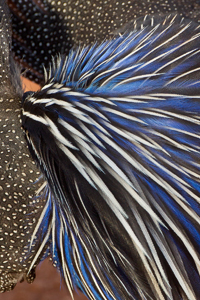
Foreign travel is exciting, but it can be exhausting for some. You very well may need to sit out a game drive and relax one day, and if you feel this way, please do so. We press fairly hard, but we do so because we know that many in the group have high-energy reserves, limited budgets, and inexhaustible enthusiasm, and these folks want as much out of the experience as they can get. We aim to deliver that.
While your photography and enjoyment is always uppermost in our minds and in our concerns for you, the welfare of our wildlife subjects still comes first. There are no exceptions to this. We do not purposely flush a bird to get a flight shot and we won't tolerate a guide or a participant doing so. If we feel an animal is stressed, we leave.
Our safaris are true wildlife experiences and are not visits to a zoo, and some photographers will see things, while others may miss things, as we travel about. Still, all of our vehicles have radios to inform everyone when there is a great sighting and most of the time everyone gets great shots of whatever subject we're shooting.
About Your Leaders
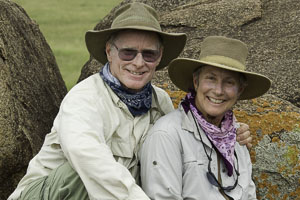 My wife Mary Ann and I strive to provide the most comfortable and thorough safari you will experience. Both Mary and I are professional photographers, and I'd hope you've seen our credits. These included National Geographic, National Wildlife, Ranger Rick, Natural History, Living Bird, Birder's World, and most nature/wildlife calendars.
My wife Mary Ann and I strive to provide the most comfortable and thorough safari you will experience. Both Mary and I are professional photographers, and I'd hope you've seen our credits. These included National Geographic, National Wildlife, Ranger Rick, Natural History, Living Bird, Birder's World, and most nature/wildlife calendars.
As a husband/wife team, Mary Ann and I have won more times in the prestigious BBC Wildlife Photographer of the Year competition than any one. To date we have had 15 firsts, seconds, or thirds -- and we have not entered every year. Our trips are not about us, however, they are all for you, but credentials seem to matter, and we have them.
Mary has written twenty-nine (29) children's books, including Leopards, Grizzly Bears, Woodpeckers, Flying Squirrels, Sunflowers, Cobras, Jupiter, Boas, Garter Snakes, Pythons, Rattlesnakes, Ducks, Chickens, Horses, and Cows, and a coffee table book, Out of the Past, Amish Tradition and Faith.
I've written several how-to wildlife photography books -- A Practical Guide to Photographing American Wildlife, The Wildlife Photographer's Field Manual, The Complete Guide to Wildlife Photography, Designing Wildlife Photographs, Photographing on Safari, A Field Guide to Photographing in East Africa, and the New Complete Guide to Wildlife Photography, African Wildlife, Creatures of the Night, The World's Deadliest, and several ebooks. We have produced an instructional video, A Video Guide to Photographing on Safari with Joe and Mary Ann McDonald.
We are both editors for Nature Photographer magazine.
In addition to leading our trips to Tanzania, Mary and I personally lead photo safaris to Kenya, Brazil's Pantanal, Chile, Galapagos, Svalbard, India, Alaska, Rwanda, Yellowstone, Ecuador, Costa Rica, the Falklands, Antarctica, South Texas, Arizona, and some other spots, too!
For some real insight into all aspects of a photo safari,
order our DVD Photographing on Safari
which covers and illustrates various camps,
how to shoot from the vehicles, what to pack,
and most importantly, what you'll photograph
and how you'll do so.
The video does not address digital workflow or digital
shooting.
Scroll through a Kenya Portfolio
Contact us by e-mail. at: info@hoothollow.com
Or Call (717) 543-6423 or FAX us at: (717) 543-5342
KENYA!
Fall 2015 Photo Safaris
The Most Productive
Photo Safari Possible!
Our 28th Year doing Kenya Safaris!
Kenya's recent terrorism attacks were
hundreds of miles from any of our photo
destinations. On safari you are as safe as
you would be in Miami or New York, and
probably safer! We would not travel to
Kenya if we did not feel it was safe to do so.
No American Photographers have more
field experience leading photo safaris
to East Africa.





PRICES:
Trip #1: October 17-31, 2015 Price: $9,995
(single supplement $ 1,441 - high season)
Trip #2: November 7-21, 2015 Price: $9,995
(single supplement $ 1,300 - off-peak season)
Note: There is a 6 participant Rwandan Gorilla trek in between
our two Kenya photo safaris. You may wish to combine this
breath-taking experience with your photo safari.
To get the absolute most out of these safaris,
consider taking one of our
Complete Digital Nature Photo Courses
next summer!
PLEASE NOTE - Prices listed are based upon 10 participants.
There will be a small surcharge if the safari has fewer participants.
See below (What's Included) for the rationale and advantages.
If you're interested in one of our safaris, contact our office ASAP!
We are offering trips based on the land cost only.
We've done this to allow our participants to either utilize air miles,
or to amass air miles with their favorite airline.
Our travel agent can also book flight arrangements for you.
Simply inquire at our office for further details.
Special Photographic Safaris to the Top Three Game Parks:
Samburu Game Reserve, Lake Nakuru National Park, and the Masai Mara Game Reserve
An Exclusive Shoot
Limited to Ten Photographers
Two non-photographic spouse seats are available per safari
Only three photographers per Toyota LandCruisers


This is the complete brochure. It is lengthy and comprehensive, and will take a few minutes to read.
For even more information, please read any of our TRIP REPORTS which detail, day-by-day, the safaris
from that year. This will give you an excellent idea of what our trips are all about, what we see,
and perhaps most importantly, how successful these trips are!
You can read all of our Kenya Trip Reports for even more information.
Order our Photographing on Safari video
General photo safaris information.
Contents
What We Have to Offer that is so Unique
Why do we offer trips in the Fall?
The Three Best Photographic Locations
Who is this Safari for?
What you can expect
Our Itinerary
What's Included
My Objective Our Role as Leaders, and Your Role
About Your Leaders



We have over 25 years experience in East Africa, we visit the three best and most diverse locations for photographers, and we tailor the trip for photographers. We discourage casual tourists from joining us unless they know what they're getting into (so continue reading the brochure). We strive for quality photography that not only includes great portraits but, more importantly, great behavior, too, and to photograph action or behavior one must have patience. You will shoot a complete portfolio of African wildlife, but hopefully your images will be a cut above the rest in also including images of wildlife in action, actually doing something! We are the only operators who visit three different locations in the Masai Mara, which provides far more chances for encountering lion or cheetah cubs, gnu river crossings, and a broader range of species.
What we have to offer that is so Unique
My wife, Mary Ann, and I have been leading Photo Safaris to Kenya
and to many other locations in Africa for over twenty-eight years. We were the first to:
institute using radios for vehicle-to-vehicle communication,
the first to offer just three photographers per vehicle,
and the first to fine-tune an itinerary that is now copied by most photo safari.
More importantly, WE KNOW AFRICA, we know how to photograph it,
what to look for, and how to get the best a situation has to offer, both for ourselves and,
most importantly, for the participants that travel with us.
 If you look at any of the Trip Reports, you'll get a great idea about our safaris, perhaps even more than what is in this brochure. I cannot stress enough how important experience is when leading a photo safari. We know what to look for, what to listen for, and what to expect, and this translates into imagery that is not simply a matter of luck.
If you look at any of the Trip Reports, you'll get a great idea about our safaris, perhaps even more than what is in this brochure. I cannot stress enough how important experience is when leading a photo safari. We know what to look for, what to listen for, and what to expect, and this translates into imagery that is not simply a matter of luck.
The topics addressed below should answer virtually all of your questions,
and I hope you'll take the time to read them.
I'd like to stress again here that our trips may not be for everyone. They are not 'tourist safaris' where the goal is to simply have you check off the different animals. We invest quality time with our subjects, we don't just see and go. Although we might spend hours with some subjects, when the potential warrants it, our participants still end up seeing everything, but they will be seeing wildlife with absolute quality. The Trip Reports will prove those points.
I do not believe anyone can offer you a better safari.
We know Africa, we know how to make a safari run smoothly, and we know the wildlife.
If you are interested in obtaining quality photographs, in seeing wildlife in-depth, in watching behavior, and witnessing truly once-in-a-lifetime wildlife opportunities, then our safaris are for you.



Why do we offer trips in the Fall?
 October through early December is one of the slower seasons for tourism in Kenya, except for our safaris and other canny photographers who follow our lead. It is still a most spectacular time of year to visit Kenya, for during this time the wildebeest migration may be 'in', and the short rainy season usually develops sometime during this period, giving us great cloudscapes and skies for some of our shooting.
October through early December is one of the slower seasons for tourism in Kenya, except for our safaris and other canny photographers who follow our lead. It is still a most spectacular time of year to visit Kenya, for during this time the wildebeest migration may be 'in', and the short rainy season usually develops sometime during this period, giving us great cloudscapes and skies for some of our shooting.
If the migration arrives, the bountiful supply of food often stimulates the predators into initiating a mating. Not being far-sighted, lions revel in the abundance of food present at the time, even though the herd may be gone by the time any young are born. Typically, the months following the migration is the time of lion babies, even though this season can be one of extreme stress, as the huge herds of easy game are gone.
 Traditionally, in the 'old days,' the wildebeest migration arrived in the Masai Mara in July, and remained only until September. Whether it is global warming and a disruption in the normal rain cycle or factors we cannot understand or predict, mow-a-days the migration can occur at any time, and over the last several years virtually every one of our safaris has experienced at least one river crossing. One should certainly not base their taking a trip on the 'migration' alone, for a river crossing, while dramatic and exciting, may not yield the types of photography one might expect from seeing nature films. Crocodile kills are indeed rare, as the crocs feed most heavily when the first herds cross the Mara River. Later in the season kills are sporadic. Of course, other predators often lurk in the riverside vegetation to make kills, and it's possible to see, and film, both leopards and lions taking down wildebeest as they make a crossing.
Traditionally, in the 'old days,' the wildebeest migration arrived in the Masai Mara in July, and remained only until September. Whether it is global warming and a disruption in the normal rain cycle or factors we cannot understand or predict, mow-a-days the migration can occur at any time, and over the last several years virtually every one of our safaris has experienced at least one river crossing. One should certainly not base their taking a trip on the 'migration' alone, for a river crossing, while dramatic and exciting, may not yield the types of photography one might expect from seeing nature films. Crocodile kills are indeed rare, as the crocs feed most heavily when the first herds cross the Mara River. Later in the season kills are sporadic. Of course, other predators often lurk in the riverside vegetation to make kills, and it's possible to see, and film, both leopards and lions taking down wildebeest as they make a crossing.
One thinks of the migration in terms of these river crossings, but the migration phenomenon encompasses the entire spectacle - herds grazing across the plains in huge scattered groups, moving in long lines that may extend for miles, and, of course, crossing the rivers too. Herds do not have to cross a dangerous river to enter into the Masai Mara from Tanzania, and many come up and return south without ever having done so. So the migration is just one aspect of the trip.
Our autumn trips usually coincide with the short rainy season - either in the middle of it, or catching either the front or back end. Why travel to Kenya if it's raining?  Well, for one, the rains are short - typically they occur in the late afternoon, and they are scattered. It's entirely possible to do a game drive and have rain clouds visible at all four compass points, and yet be rainless. Rains are usually short, too, and rarely compromise a game drive.
Well, for one, the rains are short - typically they occur in the late afternoon, and they are scattered. It's entirely possible to do a game drive and have rain clouds visible at all four compass points, and yet be rainless. Rains are usually short, too, and rarely compromise a game drive.
However, rains generate action! The skies in the afternoon are often magnificent, as thunderheads build up into dramatic skyscapes. Landscape images are far more interesting with a great sky. Rain induces bird nesting activity, and weavers, social weavers, and hornbills actively nest when mud or new grasses are available.
Typically, mornings begin cloud free and brilliant, with clouds building during the day. This provides photographers with the opportunity to shoot subjects in two lighting conditions - in bright light in the AM, and, perhaps, overcast conditions in the afternoon. As one would expect, along the equator the heat builds up through the day and, on a cloudless day, it can get rather warm by late afternoon. Clouds cool things off, so nocturnal animals, like leopards, are much more likely to be active on a cool day than on a hot, sunny afternoon. Another perk for this season!
 We'll be visiting three locations on this safari. Samburu, in the arid, semi-desert area of north central Kenya, Lake Nakuru, mid-way on our journey from one reserve to the other, and the Masai Mara along Kenya's southwestern border.
We'll be visiting three locations on this safari. Samburu, in the arid, semi-desert area of north central Kenya, Lake Nakuru, mid-way on our journey from one reserve to the other, and the Masai Mara along Kenya's southwestern border.
Samburu at this time of year should be filled with bird life. The short rains should have some influence on the landscape and with luck the vegetation will be morphing from dry season brown to verdant short-rain green. Bird activity can be one of your trip highlights here! Of course, the usual wildlife - elephants, the herd animals and ungulates, and the predators will be in their normal numbers, but the bird life can be outstanding.
It is too long a drive to travel from Samburu to the Mara in a single day. We'll be overnighting at Lake Nakuru, arriving in time for a late lunch. After lunch we'll do an afternoon game drive, and another all-morning game drive where we'll concentrate on the incredible flamingos.
Once in the Mara we will spend several days at Sarova Lodge, Mara Serena, and at Mara Intrepids, traveling to each new camp as part of our morning game drives. By basing ourselves at several different locations in the Mara, we will enjoy the maximum amount of time at all three of the hottest areas for lion and hyena activity, as well as plenty of time in prime areas for cheetahs, leopards, elephants, antelope and the resident ungulates. Unlike any other safari, you will see all three main parts of the Mara and experience the magic that each area provides to photographers and naturalists alike.
Of course, while our trips are timed to coincide with the short rainy season, the rains, like anything in nature, are never guaranteed. Regardless, however, the fall and the lack of crowds makes this season our absolute favorite for photographing in Kenya.
To sum up, our focus of this trip will include the following:
Bird life in Samburu - One of the most surprising aspects to many safari photographers is the amount and variety of bird life available, and how much fun photographing the birds can be. Samburu is the premiere bird location, with a large variety of birds of prey, as well as diverse other birds, including owls, ground-dwelling birds, colorful bee-eaters and kingfishers. Many of the tracks run through vegetation that is no higher than our vehicles' roofs, so eye-level shooting is easy.








Mammals in Samburu - The elephant action in Samburu can be outstanding.
Several endemic mammals are found nowhere else (see our itenerary), including the upright-standing gerenuk,
the tiny dik-dik, the unicorn-like oryx, and the reticulated giraffe.
We'll have one of our best chances of photographing a leopard here.



Birds and Mammals in Nakuru - although we'll only be spending a short period of time here, we'll have
ample opportunity for photographing flamingos (should water levels permit), and other birds. Additonally, Lake Nakuru is great for White Rhinos, African Buffalo, and much of the plains game.

Predatory Action in the Mara - Lions and Cheetahs are likely to be hunting, and if there is any
possibility of photographing incredible action, we will do it.



Baby Predators in the Mara - We usually get lion cubs and cheetah cubs. One of the true advantages to our safaris, and this is truly unique, is our staying at three different, widely spaced lodges in the Masai Mara. By doing so, we can cover virtually the entire area, which is simply not possible if you are based at only one location, as most safaris are. In this way, we have the best chance of finding and photographing these appealing babies!



The Usual Stars - of course, we'll also be photographing all the mammals we normally encounter, which include leopards, cheetahs, elephants, hyenas, the hoofed animals, and the birds in Nakuru, the Mara, and Samburu.



Read on for a more thorough description of the three main areas of shooting.
Featuring the Three Best Photographic Locations in Kenya
There is no place in the world like Kenya. A country about the size of Texas it preserves some of the greatest wildlife concentrations in the world. Just as importantly, however, Kenya is probably the best African country for affordable game viewing and wildlife photography. Kenya is a comfortable, safe country, where the wildlife is accustomed to people and to a close approach by vehicles.
Many safaris attempt to see too much in a very limited period of time. Consider this: If you've ever driven through Texas you know how large a state it is. Could you imagine trying to cover that state, photographically, in just 14 days afield? It couldn't be done, unless you limited yourself to just a few key representative locales.
The same holds true for Kenya. It's impossible to do a quality shoot where five to seven different parks are visited on a two or three week trip. Doing so would limit you to only a day or two per park, and most of your time would be spent in traveling. WE WON'T BE DOING THAT! Instead, we'll concentrate our time at the two best national parks and reserves for photography, which represents two very diverse regions. Doing so we'll have the luxury of time, being able to spend a number of days at each location, and of seeking out specific subjects, rather than simply contenting ourselves with what luck may provide.



Samburu Game Reserve's semi-desert habitat hosts unique species to the country, including reticulated giraffe, distinguished by a net-like pattern; gerenuk, giraffe-like antelope that feed while standing on their hind legs; Grevy's zebra, with thin stripes and a white belly; Beisa oryx, huge antelopes with long, straight horns that may have originated the unicorn legend; and a variety of birds. Samburu affords the best chances at filming pale-chanting goshawks, hornbills, vulturine guineafowl, yellow-throated spurfowl, and dozens of other species. Samburu is also an excellent location for leopard: we don't always get them there (5 of 6 safaris we lead usually do) but the leopards we get are usually excellent for filming (my Feb. '90 Natural History Magazine cover was taken at Samburu and Mary's BBC winning leopard in '98).
 Lake Nakuru supports one of the largest populations of lesser flamingos in the world, and in good years there are, quite literally, millions of birds along the shorelines. Nakuru is also quite good for leopard, and sometimes great Lions. Nakuru offers other great subjects that you are quite likely to film very well, including African buffalo, DeFassa waterbuck, impala, warthog, reedbuck, Rothschild giraffe, and olive baboon.
Lake Nakuru supports one of the largest populations of lesser flamingos in the world, and in good years there are, quite literally, millions of birds along the shorelines. Nakuru is also quite good for leopard, and sometimes great Lions. Nakuru offers other great subjects that you are quite likely to film very well, including African buffalo, DeFassa waterbuck, impala, warthog, reedbuck, Rothschild giraffe, and olive baboon.
If our trip ended after Samburu and Nakuru you'd have had a fantastic experience. However, the Masai Mara Game Reserve is the 'dessert,' and is viewed by many as the premier wildlife photography location in Africa. This great game location will be our last stop on our photographic adventure.
 The Masai Mara is considered part of the famous Serengeti ecosystem, but differs in offering a variety of habitats. Within a morning's game drive one can film short grass high country, tall grass prairie, riverine forests and thickets, and acacia thorn scrubland. Elephants, hippos, Masai giraffe, common zebra, gnu, impala, Thompson's and Grant's gazelles, topi, hartebeest, hyrax, black-backed jackal, spotted hyena, cheetah, leopard, and lion are permanent, and fairly common, residents within the park. There's also several less common species of antelope, including reedbuck, bushbuck, steinbuck, oribi, and duiker, that we normally encounter.
The Masai Mara is considered part of the famous Serengeti ecosystem, but differs in offering a variety of habitats. Within a morning's game drive one can film short grass high country, tall grass prairie, riverine forests and thickets, and acacia thorn scrubland. Elephants, hippos, Masai giraffe, common zebra, gnu, impala, Thompson's and Grant's gazelles, topi, hartebeest, hyrax, black-backed jackal, spotted hyena, cheetah, leopard, and lion are permanent, and fairly common, residents within the park. There's also several less common species of antelope, including reedbuck, bushbuck, steinbuck, oribi, and duiker, that we normally encounter.
The very endangered black rhino has made its last stand in the Mara here. We've had luck on many of our trips finding rhinos with calves, and we'll hope to do so again this year. Additionally, serval (a small spotted cat) are most easily found here, and in the scattered acacia trees leopards hang their carcasses out of reach of the many lions. Consequently, it's easiest to find tree-climbing leopards here.
The Mara, however, is diverse, and it is impossible to do the Park justice by basing out of only one lodge. To cover the park thoroughly we'll be based out of three different lodges. In the extreme south we'll stay at Mara Sarova, covering the area from the Talek and Sekanani gates southward to the border of Tanzania and the Serengeti National Park. We'll stay at Mara Serena Lodge, covering the Mara Triangle and southwestern corner; and in the northern section we'll stay at Mara Intrepids, covering the area from the Musiara Marsh to the Talek River including Rhino Ridge and Paradise Plains.
The very endangered black rhino has made its last stand in the Mara here and we have a great chance of photographing one amidst the croton bush thickets. In the absence of Maasai persecution, the lions and hyenas are active during the day.




Who Is This Safari For?
 This safari is really for anyone who is serious, either about wildlife and nature photography, or about in-depth, intense, and patient animal viewing. The two, for a photographer, are the same, for patience, time, and luck are required in order to obtain great wildlife images. Please read the following section carefully. While almost everyone who travels with us are like-minded, there are, on occasion, one or two people who are not. This is not a safari for tourists. This is a safari for photographers - serious amateurs or photo enthusiasts or pros, and for those who really want to do a safari right.
This safari is really for anyone who is serious, either about wildlife and nature photography, or about in-depth, intense, and patient animal viewing. The two, for a photographer, are the same, for patience, time, and luck are required in order to obtain great wildlife images. Please read the following section carefully. While almost everyone who travels with us are like-minded, there are, on occasion, one or two people who are not. This is not a safari for tourists. This is a safari for photographers - serious amateurs or photo enthusiasts or pros, and for those who really want to do a safari right.
 Actually, it really doesn't matter to us if you bring a camera or not, or if you do not have long telephoto lenses or professional gear along. That is, provided you are patient, willing to wait, and, above all, considerate to those photographers who do have gear that requires a rock-steady vehicle when they're about to shoot. Patience, to a wildlife photographer, is NOT a relative term. Patience may not be a five-minute wait. It may mean waiting an hour before a cheetah and her cubs decide to move from a croton thicket, or before a den full of hyena cubs wake up and begin to play. We have literally waited for four or five hours for a wildebeest river crossing. Photographers, avid naturalists, artists, and others who are serious about wildlife have no problem with this. You might.
Actually, it really doesn't matter to us if you bring a camera or not, or if you do not have long telephoto lenses or professional gear along. That is, provided you are patient, willing to wait, and, above all, considerate to those photographers who do have gear that requires a rock-steady vehicle when they're about to shoot. Patience, to a wildlife photographer, is NOT a relative term. Patience may not be a five-minute wait. It may mean waiting an hour before a cheetah and her cubs decide to move from a croton thicket, or before a den full of hyena cubs wake up and begin to play. We have literally waited for four or five hours for a wildebeest river crossing. Photographers, avid naturalists, artists, and others who are serious about wildlife have no problem with this. You might.
 We want to make this clear. Great shots often require patience. If you simply want to see animals, click off a few pictures, and move on to another subject, then our safari is not for you. You might worry that 'spending time' waiting is wasteful, and that your time would be better spent roaming and looking for new subjects. Let me assure you that in the course of a two-week trip you will indeed see everything, but some subjects, that require waiting will reward you with extraordinary images for your patience. In other words, you'll see everything the normal tourist sees (or the impatient photographer), but you'll also see, with quality, other subjects, events, or activities that most simply do not see because they do not have the patience to wait. We do.
We want to make this clear. Great shots often require patience. If you simply want to see animals, click off a few pictures, and move on to another subject, then our safari is not for you. You might worry that 'spending time' waiting is wasteful, and that your time would be better spent roaming and looking for new subjects. Let me assure you that in the course of a two-week trip you will indeed see everything, but some subjects, that require waiting will reward you with extraordinary images for your patience. In other words, you'll see everything the normal tourist sees (or the impatient photographer), but you'll also see, with quality, other subjects, events, or activities that most simply do not see because they do not have the patience to wait. We do.
 For example, even our extremely experienced Kenya safari driver/guides have seen things with us that they have never seen before - and these are guides who, collectively, have over forty years driving experience. This has included such experiences as a zebra stallion killing a foal; a zebra giving birth; lions killing a bull buffalo; elephants, en masse, wrestling in the river; a leopard killing a wildebeest, or a warthog; ostriches hatching from eggs; lions pulling a warthog from its den; and much, much more. Why? I asked our driver/guides this, and they said, 'because your groups stay and watch. Most groups do not, and only spend enough time to make some pictures.' They miss these unique events, and so, obviously, had the driver/guides.
For example, even our extremely experienced Kenya safari driver/guides have seen things with us that they have never seen before - and these are guides who, collectively, have over forty years driving experience. This has included such experiences as a zebra stallion killing a foal; a zebra giving birth; lions killing a bull buffalo; elephants, en masse, wrestling in the river; a leopard killing a wildebeest, or a warthog; ostriches hatching from eggs; lions pulling a warthog from its den; and much, much more. Why? I asked our driver/guides this, and they said, 'because your groups stay and watch. Most groups do not, and only spend enough time to make some pictures.' They miss these unique events, and so, obviously, had the driver/guides.
 That said, we are not tyrants . We realize everyone has their own patience and frustration level, and perhaps their own desire to shoot particular subjects. One of the values of traveling with us is we can guide you, by stating our belief whether we feel something is worth waiting for, or not. Our rule is this: If you don't wish to stay, you can leave, provided everyone in your vehicle agrees on this, or if at least three in total from all of the vehicles agree to leave, whereupon we'll rearrange seating to allow those people to return to camp or continue on their way. We have, on many occasions, put three or four people into a van to head back to camp for lunch while the die-hards stayed behind, waiting for the cheetah to make its kill or for the wildebeest to cross the Mara river. In most instances, the cheetah killed, and the wildebeest crossed, right after the other van left!
That said, we are not tyrants . We realize everyone has their own patience and frustration level, and perhaps their own desire to shoot particular subjects. One of the values of traveling with us is we can guide you, by stating our belief whether we feel something is worth waiting for, or not. Our rule is this: If you don't wish to stay, you can leave, provided everyone in your vehicle agrees on this, or if at least three in total from all of the vehicles agree to leave, whereupon we'll rearrange seating to allow those people to return to camp or continue on their way. We have, on many occasions, put three or four people into a van to head back to camp for lunch while the die-hards stayed behind, waiting for the cheetah to make its kill or for the wildebeest to cross the Mara river. In most instances, the cheetah killed, and the wildebeest crossed, right after the other van left!
Non-Photographers, Artists, and Videographers - Please Note
As I've already stated, photographers will get the most out of this trip, rather than the average tourist. Non-photographers might feel frustrated in not being able to produce images that others can; but that thought alone may be motivation for you to buy a telephoto lens and camera before doing the trip. I'd recommend doing so. Artists can benefit from our type of safari as well. If we're waiting for cheetahs to hunt, or for lions to resume mating, there's usually time to do field sketches or character studies. However, if you are an artist, don't be upset if your vehicle moves while you're still drawing! This is, FIRST AND FOREMOST, a photography trip, and the photographers have the final say. This also applies to people doing video. Still photography is all about 'the shot' and not screen continuity where an animal walks off to finish a video sequence. While that's happening, for a video shooter, a still photographer might be missing dozens of great shots if the vehicle had only followed. Consequently, our driver/guides and our photographers know that we will move to get the shots. Some video photographers may be frustrated by this, but the goals of a serious video photographer and a serious still photographer may be at odds, and this is a photography trip.
Our Unique and Fair Rotation System
We do not assign people to one vehicle for the entire trip. Instead, we rotate everyone through our vehicles so that everyone has a chance to shoot with each other (avoiding trip-damaging cliques) and to shoot with both Mary and me.
Our rotation system gives everyone equal time with Mary and with me, and as we 'captain' our respective vans you can be assured that we'll do our best to put you in the best shooting situation as we read the light, determine animal behavior, or just simply look after you for the shots you're seeking but have not yet achieved.
Make no mistake: Mary and I are here to work. I joke that when you're with me you'll get the best photos, and Mary says the same thing. But the fact is, you will probably get your best shots on those occasions with either of us, on average. But the point is, we're not going through the motions here. We're out to make the best photographs we can, and you'll get those same images when you're with us. That's not to say that when you're not with us you won't do well -- this isn't a zoo, and you might see something that we don't, but what we are saying is we're always trying to make the best images for our clients and for ourselves.






Consider this, too. Mary and I have seen scores of wildebeest river crossings, and dozens of cheetah kills.
In truth, we probably have our best river crossing shots already in file. But YOU DON'T, and we realize this, and that's why we urge you to be patient, to wait, and to see the wonderful things that we have already seen. But we also know that each kill is different, each river crossing is different, and that any event in nature has the absolute potential of unfolding into the greatest spectacle we've ever seen. So, remember, when you are in our care, we are looking out for you, we're trying to get you the best shots possible, and we are willing to put in the time for these events to occur. You should be, too.
Are you willing to eat a modest picnic breakfast afield rather than return to camp for a big cooked breakfast? If you answer this question with a Yes, then this trip will be for you and you'll fit in with the type of gung-ho photographer we attract. Are you willing to eat the leftovers from breakfast, or your 'emergency' Granola bars, for lunch instead of returning to camp to eat a cooked lunch if the shooting requires this? On an average we generally miss ONE lunch because of a hunting cheetah.
Regarding breakfasts, we always eat a picnic breakfast in Samburu and the Masai Mara. It doesn't make sense to return from the field while the light is still great just to eat. Instead, whenever we have a lull in activity, we park our vehicles and grab breakfast then. As stated above, normally we do not stay out all day, although if something is very good, or promising, we will. That means that sometimes we'll miss lunch (or we'll come in for a very late lunch), and for that reason we advise people to pack candy or granola bars for a quick snack. We usually do return for lunch, however, since at high noon the light is high and extremely contrasty and almost all animal activity ceases in the hottest hours. However, if you're concerned about eating the meals you paid for, and of sleeping in when you wish, then I don't think our trips will be for you. With us, photography comes first. Especially with the heat of Samburu, we're usually in by 11:30AM, although on cloudy days, or when there was extraordinary action, we've come in closer to 1PM.
Our personal safaris with three per nine passenger vehicle are radically different from the typical 15-20 person safari crammed with five to nine passengers to a van or a tour 'limited' to twenty or more people. For that reason this safari is naturally more expensive, but in reality it's not that much more. Please, just ask yourself what your objective is:
Is it to see Kenya and to take snapshots, or to be on a special photo safari designed to provide the best shooting opportunities possible. If your answer is the latter, then this safari is for you.
What You Can Expect from Us
 From Kenya you can expect the best, most exciting wildlife photography possible on this planet. I liken Kenya to doing a shoot combining the best of three great US destinations -- Denali, Yellowstone, and the Everglades, for there are large mammals, birds, and scenics, all possible in one locale the size of Texas, and we'll be concentrating on one very small portion of that area.
From Kenya you can expect the best, most exciting wildlife photography possible on this planet. I liken Kenya to doing a shoot combining the best of three great US destinations -- Denali, Yellowstone, and the Everglades, for there are large mammals, birds, and scenics, all possible in one locale the size of Texas, and we'll be concentrating on one very small portion of that area.
We will prepare you photographically. I've written a shooting guide to Kenya that you can use as a handbook or reference when considering composition and exposure for most of your shooting subjects. Prior to the trip we'll provide you with our own recommendations on the gear to bring and, on safari, we'll provide thorough briefings on the subjects we expect to film and how to do so. We have a video as well, that describes the camps, the food, the shooting arrangements with the vehicles, and also provides important information on the natural history of most of the subjects you'll see, as well as our photographic tips for these subjects. You can order the video directly from our office.
Finally, in the field you'll be with either Mary or myself on an average of two out of every three game drives. As I mentioned earlier, we'll do our best to get you the best shots possible, and we'll be able to provide you with our suggestions on composition and exposure and, perhaps most importantly, on what we expect to happen and where we should be. Knowing animal behavior is a real plus, if not a key to successful wildlife shooting, and our experience, and that of our fantastic Kenyan driver/guides, will insure we have the best chance at obtaining great images.
Hopefully, too, you can expect great images of:
 The Leopard: Leopards are elusive, solitary creatures. Surprisingly common, they are difficult to see, well-camouflaged, shy, and retiring. They are the trophy of any safari, and the hardest cat to film. I've never missed with leopard, in FIFTY trips, but I'm always worried, and we work hard to get this cat!
The Leopard: Leopards are elusive, solitary creatures. Surprisingly common, they are difficult to see, well-camouflaged, shy, and retiring. They are the trophy of any safari, and the hardest cat to film. I've never missed with leopard, in FIFTY trips, but I'm always worried, and we work hard to get this cat!
The Cheetah: Spotted, elegant, and surprisingly tame, this cat of the open grasslands is the easiest to film, once encountered. We'll spend approximately half the trip in the best locale in Kenya (the Masai Mara) for cheetahs, and we'll have an excellent chance of filming this, the fastest land animal in the world. Filming it hunting, however, will require luck and patience, although we should have the opportunity to do exactly that. Hunting cheetahs require patience, and this is the day we often miss lunch.
The Lion: The king of beasts appears to be anything but as it sleeps beneath an acacia. Stare into a male's eyes, or watch one snarl, or half-rise as if to charge, and you'll quickly understand how and why the lion got its title. Lions are easy to see, and in the Mara they can be surprisingly common. Photographing lions in action, however, is quite different from the sleepy views most tourists see. We'll be out early to catch any dawn hunts, and staying with a pride if hunting activity looks promising.
Black Rhinos: We may have an opportunity to photograph this endangered species in the Mara, and at two of our lodges we'll be in prime rhino country. We're usually very successful! We'll also have a good chance for black rhinos, and an excellent chance for white rhinos, when we are at Lake Nakuru.



Elephants: Both Samburu and the Masai Mara have very healthy elephant populations. Depending upon the rains, elephants may put on a great show in Samburu, or be absent. In the Mara, elephants are common and easy to find; and make for wonderful, animated subjects.
Lesser Predators and the Herbivores: Typically, we also have great luck with hyenas, black-backed jackals, side-striped jackals, serval cats, and bat-eared foxes. We usually photograph three different primates - olive baboons, vervet monkeys, and colobus monkeys, and virtually all the herbivores - elephants, buffalo, zebras, antelope, hippos, warthog, etc. We typically have luck with some of the less common species, too, like greater kudu, steinbok, oribi, and klipspringer, but these, among the antelopes, are the real trophies and are not a 'given.'
Why we have such great success...

We'll have a wide variety of animals and birds available at our three destinations. With radios in each of the vehicles our groups can game drive independently, but can meet whenever a great subject is spotted. Unlike many other tours our vehicles often game drive separately, fanning out to cover the largest area possible. In this way, when one of our vehicles spots a leopard, or cheetah, or baby elephant, or similarly great subject, everyone has the opportunity to photograph that subject, too.
We are also the only safari operators who rotate our participants in a fair basis throughout all the vehicles so that you see and work with all the driver/guides, the other participants, and with Mary and I. Our rotation -- done for both morning and afternoon game drives -- insures that you see Mary and I an equal number of times (we feel that you will get your best shots when you are with us, an ego thing, sure, but we know what we're doing!), an equal number of times with the various driver/guides, and as diverse a rotation as can be accomplished in being with the other participants on the trip. In this way our groups become tightly knit into one big happy family.!
Our Itinerary
 As this itinerary is planned nearly a year in advance, there's always the possibility of slight changes -- in day rooms, flight times, etc. However, the actual field time is almost never affected by last-minute airline or hotel changes.
As this itinerary is planned nearly a year in advance, there's always the possibility of slight changes -- in day rooms, flight times, etc. However, the actual field time is almost never affected by last-minute airline or hotel changes.
Day 1, Arrive in Nairobi in the late evening or early hours of Day 2. Overnight: Nairobi Serena Hotel, Nairobi.
Day 2, We'll depart around 9:30AM for our drive to Samburu Game Reserve, arriving in time for a very short (non-photographic) game drive as we drive to our lodge. Overnight: Elephant Bedroom Camp.
Elephant Bedroom Camp is a beautiful introduction to our safari experience, with only 12 luxury tents situated in the heart of elephant country. The staff and the food and the accommodations are incredible, and we couldn't imagine a better place to start our photo safari.
 Day 3-5, Samburu Game Reserve. Over the next three days we'll concentrate upon the wildlife, birds, and scenery that characterize one of Kenya's prettiest parks. Along the river we'll seek elephants coming to drink and play, crocodiles lying in wait for prey, and monkeys using the riverine forest for shelter. Samburu may offer us leopard (it usually does), our best close-up opportunities for bird photography, and unusual endemic mammals, including oryx, gerenuk, dik-dik, reticulated giraffe, and Grevy's zebra. By the end ofour third day we should have everything captured on film, ready to press on to our next destination.
Day 3-5, Samburu Game Reserve. Over the next three days we'll concentrate upon the wildlife, birds, and scenery that characterize one of Kenya's prettiest parks. Along the river we'll seek elephants coming to drink and play, crocodiles lying in wait for prey, and monkeys using the riverine forest for shelter. Samburu may offer us leopard (it usually does), our best close-up opportunities for bird photography, and unusual endemic mammals, including oryx, gerenuk, dik-dik, reticulated giraffe, and Grevy's zebra. By the end ofour third day we should have everything captured on film, ready to press on to our next destination.
Overnights, Elephant Bedroom Camp.
Day 6, Samburu to Lake Nakuru. We'll leave Samburu, early, for our next destination, Lake Nakuru. We'll arrive in time for a late lunch. After lunch we will do a late afternoon game drive where we may film African white pelicans, flamingos, and White Rhinos, the only location where we will have this species. Leopards, and even tree-climbing lions, can be seen in the yellow-barked acacia forests.
Overnight, Lion Hill Lodge.


 Day 7, Lake Nakuru to the lower Masai Mara. After an early breakfast we'll do a morning game drive where we'll work on white rhinos, lesser flamingos, and whatever other species we encounter. Nakuru hosts black rhinos, too, and we sometimes get both on a single game drive. Additionally, there are several species of plains game we'll also see in the Mara, including Thompson gazelle, warthog, Defassa waterbuck, and common zebra. Nakuru has an endangered subspecies of giraffe, the Rothschild giraffe, and we're fairly likely to see and photograph this species. We'll leave the park in late morning and head to our final shooting destination, the Masai Mara. En route we'll stop for lunch before continuing to the southern end of the Masai Mara arriving right before sunset. The Mara is Maasai country. The grass grows high, and lions are common and active during the daylight hours.
Day 7, Lake Nakuru to the lower Masai Mara. After an early breakfast we'll do a morning game drive where we'll work on white rhinos, lesser flamingos, and whatever other species we encounter. Nakuru hosts black rhinos, too, and we sometimes get both on a single game drive. Additionally, there are several species of plains game we'll also see in the Mara, including Thompson gazelle, warthog, Defassa waterbuck, and common zebra. Nakuru has an endangered subspecies of giraffe, the Rothschild giraffe, and we're fairly likely to see and photograph this species. We'll leave the park in late morning and head to our final shooting destination, the Masai Mara. En route we'll stop for lunch before continuing to the southern end of the Masai Mara arriving right before sunset. The Mara is Maasai country. The grass grows high, and lions are common and active during the daylight hours.
Overnight, Mara Sarova Lodge.
 Day 8-9, Lower Mara. From our base in the southern Mara we'll concentrate on the wildlife unique to the area. There are a number of black rhinos in this section of the Masai Mara and we'll have a good chance of filming one here. Elephants are common, as are Masai giraffe, hartebeest, and topis. Here we'll have our best chances at filming lions in action, be that mating, hunting, feeding, and hopefully even making a kill. Hyenas are common, too, and with the absence of easy prey these scavenger/hunters should be quite active during the day. Always on the alert for an easy meal, hyenas are more likely to be filmed at a carcass during the day in the southern Mara than anywhere else in Kenya.
Day 8-9, Lower Mara. From our base in the southern Mara we'll concentrate on the wildlife unique to the area. There are a number of black rhinos in this section of the Masai Mara and we'll have a good chance of filming one here. Elephants are common, as are Masai giraffe, hartebeest, and topis. Here we'll have our best chances at filming lions in action, be that mating, hunting, feeding, and hopefully even making a kill. Hyenas are common, too, and with the absence of easy prey these scavenger/hunters should be quite active during the day. Always on the alert for an easy meal, hyenas are more likely to be filmed at a carcass during the day in the southern Mara than anywhere else in Kenya.
Overnights, Mara Sarova.
Day 10, Lower Mara to the Mara Triangle. We'll leave our southern base and do a morning game drive to our second great destination in the Masai Mara, Mara Serena Lodge. And I mean great! Mara Serena is probably the most beautiful lodge in all of Kenya, and the gardens have great songbirds and an exceptionally tame population of bush hyrax. But we're not there for the lodge's beauty! During the fall migration, Mara Serena is located almost directly above one of the premier river-crossing areas for wildebeest and zebras. The area can be extremely productive for lion, cheetah, serval, and black rhino, as well as giant Nile crocodiles, hippos, and elephants. One more word, though, about the lodge. It is beautiful, and the food is outstanding. There are more lights in your room than there probably are in your bedroom at home, so Serena lends itself wonderfully for catching up on battery charging, doing laptop stuff, etc. It's a great place at a great location. Overnight, Mara Serena Lodge.
 Day 11, Mara Triangle. We'll continue to game drive around the Serena area, working on lions, cheetahs, servals, and everything else. From Serena, we'll have the only opportunity available to game drive through the southwestern corner, often called the Mara Triangle, where, someday, I'm sure African hunting dogs will return. Overnight, Mara Serena.
Day 11, Mara Triangle. We'll continue to game drive around the Serena area, working on lions, cheetahs, servals, and everything else. From Serena, we'll have the only opportunity available to game drive through the southwestern corner, often called the Mara Triangle, where, someday, I'm sure African hunting dogs will return. Overnight, Mara Serena.
Day 12, Mara Triangle to Upper Mara. We'll leave Serena for our morning game drive, visiting the extreme northwestern section of the Mara Triangle (also known as the Trans Mara Conservation Area). This is a great spot for virtually all of the Mara's species, although one, the side-striped jackal, is most commonly seen in this area. At the conclusion of our morning game drive we'll leave the Park, cross the Mara River and travel through what is now Maasai country . We'll re-enter the Park near the Musiara Gate and continue to our final, EXTREMELY PRODUCTIVE, destination. That's the upper middle section of the Mara where we'll base out of Mara Intrepids Camp. After a late lunch and a short break, we'll do our first afternoon game drive in an area that has become our favorite part of the park. Overnight, Mara Intrepids Camp.
If Mary and I had only place to visit in Kenya it would be to the Upper Mara and the Mara Intrepids Camp. It is our favorite lodge and our favorite location. This tented camp is probably the least fancy of all the places we visit, but for a variety of reasons, including the fact that it 'feels' most like Africa, we love it.
 Day 13-14, Upper Mara. Although all of the Mara is rich, and the Mara Intrepids area is truly exceptional. Leopards are particularly common here. There's a great lion pride here as well, with 3 males that must rank among the most spectacular in the entire Mara. Intrepids is situated along the Talek River, and many of our game drives follow the serpentine route of the often-dry river. Because of the frequency of game drives along the river wildlife is exceptionally tame, and we've had some of our best bird of prey photography along this river including good opportunities for African fish eagles, Bateleur eagles, and kites. Intrepids' wonderful assortment of spectacular game is a fitting ending to our safari - offering the potential of some truly exciting photography. Overnights, Intrepids.
Day 13-14, Upper Mara. Although all of the Mara is rich, and the Mara Intrepids area is truly exceptional. Leopards are particularly common here. There's a great lion pride here as well, with 3 males that must rank among the most spectacular in the entire Mara. Intrepids is situated along the Talek River, and many of our game drives follow the serpentine route of the often-dry river. Because of the frequency of game drives along the river wildlife is exceptionally tame, and we've had some of our best bird of prey photography along this river including good opportunities for African fish eagles, Bateleur eagles, and kites. Intrepids' wonderful assortment of spectacular game is a fitting ending to our safari - offering the potential of some truly exciting photography. Overnights, Intrepids.
Day 15, Upper Mara to Nairobi to home. We'll have a cooked breakfast before boarding our Air Kenya flight to return to Nairobi. On your flight you'll be passing over some of the country we game drove across, providing a new perspective to your trip. You'll have the afternoon free to pack and rest, before enjoying your final, farewell dinner . The tour formally ends at the conclusion of this evening meal, with most participants taking that evening's flight home (most international departures are at night), with arrival in the US sometime on the following day after a change of planes in Europe. Day room, the Nairobi Serena Hotel.
What's Included
 The photo safari prices for our trips is based on land costs from Nairobi and includes all accommodations (double occupancy), all meals except lunch in Nairobi, park entrance fees, and ground transportation, including our exclusive three photographers per vehicles. A single rooming supplement is available. See prices above.
The photo safari prices for our trips is based on land costs from Nairobi and includes all accommodations (double occupancy), all meals except lunch in Nairobi, park entrance fees, and ground transportation, including our exclusive three photographers per vehicles. A single rooming supplement is available. See prices above.
Surcharge for less than 10 Participants
Our safari price is based upon 10 photography participants, filling the vehicles with three photographers per vehicle. While there is a surcharge if the trip doesn't fill, there is a tremendous advantage for YOU, the participant, as there will only be two photographers in these vehicles. You'll still have the benefits of our expertise when you rotate into our vehicle, but on game drives that you're not with Mary or me you have a good chance of having almost a private vehicle!
Our lodging varies from permanent tented camps to normal tourist lodges. Tented camps are permanent structures, more like a hotel room under canvas, with flush toilet, running water, and shower inside each tent. Excellent cooks prepare food and most meals have a European/British influence. You won't be eating fresh killed zebra or eggs over a campfire! Drinks are not included, but they are inexpensive.
Our price also includes the driver/guide's tip and I know that we provide our guides with one of the very best tips they receive each year. Our driver/guides are the best, experts at animal behavior and, from working with me for years, quite adept at putting us into the best spots for great pictures. I use the same guides each year and they know how I work and what's expected of them. They're great, and we love to reward them well for their efforts.
Special non-photographic Spouse Offer
 We'll be offering two spots at a discounted price for a spouse to accompany the photographer. This is the deal. The spouse will be seated in the front seat, next to the driver, for all game-drives. This is a comfortable riding position, and will afford great game-watching views and opportunities for all but those times when game is on the right hand side behind the driver. The non-photo spouse is a non-photography position, and the driver/guides will not be positioning a vehicle to accommodate the non-photo spouse, but to work for the photographers. The non-photo spouse will need to sit still during shooting times, and will not be able or allowed to climb into the back with the photographers, regardless of viewing opportunities or lack thereof.
We'll be offering two spots at a discounted price for a spouse to accompany the photographer. This is the deal. The spouse will be seated in the front seat, next to the driver, for all game-drives. This is a comfortable riding position, and will afford great game-watching views and opportunities for all but those times when game is on the right hand side behind the driver. The non-photo spouse is a non-photography position, and the driver/guides will not be positioning a vehicle to accommodate the non-photo spouse, but to work for the photographers. The non-photo spouse will need to sit still during shooting times, and will not be able or allowed to climb into the back with the photographers, regardless of viewing opportunities or lack thereof.
This offer is meant to provide couples an opportunity to travel together and to enjoy Kenya, but with the very real proviso that this does not impact upon the photography or opportunities for the 'shooters.' This is a photography trip and, spouses or not, will remain so. If interested, please inquire for the special discounted price. Further, the  non-photographic spouse is a 'non-voter' in terms of whether a vehicle stays or goes, should it occur that some photographers wish to remain with a subject and others do not. In other words, if your spouse and you (the photographer) wish to leave, but the other two photographers (three photographers per van, remember) do not, it is two for, one against, and the vehicle remains.
non-photographic spouse is a 'non-voter' in terms of whether a vehicle stays or goes, should it occur that some photographers wish to remain with a subject and others do not. In other words, if your spouse and you (the photographer) wish to leave, but the other two photographers (three photographers per van, remember) do not, it is two for, one against, and the vehicle remains.
With this in mind, we always suggest that spouses fill a photography spot even if they do not plan on shooting. Doing so allows that person more freedom of movement -- they can stand or sit, and they will have a better view of game. Non-photo spouses will be required to sign an agreement stating their knowledge of these facts, because a few spouses have, in the past, signed their non-photo spouses up without telling them any of these details, and the non-photo spouses were not happy with that arrangement!
Many non-photographic spouses have spent their time viewing game, sketching, or simply reading when the photographers were poised and waiting for activity. Some non-photo spouses elect to sit out some game drives, and have spent their time walking the grounds or writing, or going on nature walks with lodge personnel.
My Objective
 You should return with the best photographs of wildlife you've ever taken. This doesn't come easily; it requires early starts, patience, and a degree of luck. I believe any photographer traveling to Kenya wants this, and that they're more interested in filming game than they are in lounging at a pool or in having a leisurely cooked breakfast during the best shooting time of the day!
You should return with the best photographs of wildlife you've ever taken. This doesn't come easily; it requires early starts, patience, and a degree of luck. I believe any photographer traveling to Kenya wants this, and that they're more interested in filming game than they are in lounging at a pool or in having a leisurely cooked breakfast during the best shooting time of the day!
Our field days start before dawn so that we can greet the sunrise with our lenses. We'll have modest boxed picnic breakfasts on most field days, since this saves time and allows us to travel anywhere without having to worry about returning for a breakfast. Lunches and dinners are at camp, and, with the quantity of food available, I doubt if you'll miss the cooked breakfast. We may, however, occasionally miss lunch if a subject is so good that to leave it would be silly. That doesn't happen often, and if we decide to do so, we do it by group consensus. I'll tell you, when the vote comes up, when such a situation arises, people always look at me as if I'm crazy for even asking them if they wish to leave! Nonetheless, if at least three people (from x number of vehicles) wish to leave at any time, they are welcome to do so. We will not do so for only two, however. Our rule is three photographers per van, so three is the magic number.
We will stay with a subject as long as it's necessary to get great photos, provided the goal is realistic. Some animals require only a minute of work for a snap-shot like opportunity that still provides a great image. Others require work, and we've stayed with some subjects for hours (or for an entire day). Don't be afraid that by doing this you'll miss other shots. I've done enough of these (this will be my 28th year of doing Kenya safaris) that I know what's good, what's worth our time, and where our priorities should lie and also provide full coverage of everything you wanted to film.
You will amass a wonderful portfolio of all your Kenyan wildlife, but you won't be producing traditional boring tourist shots. We'll try to get you great images -- magic material! Although we won't be consciously amassing a species list, you'll undoubtedly see as many, if not even more, species of wildlife by doing it this way than you would by being a 'tourist,' since we'll be in the field longer, looking, watching, and photographing.
Our Roles as Leaders, and Your Role
 Mary and I know Kenya, its wildlife, and how to photograph it. I want everyone to obtain great photographs, and to enjoy himself or herself while doing so. Great photography requires patience, luck, and time, plus a degree of skill that my drivers/guides and Mary and I can provide. You can trust us that everything we do as your trip leaders will have those priorities - your photos and well-being as an individual in our group -- in mind.
Mary and I know Kenya, its wildlife, and how to photograph it. I want everyone to obtain great photographs, and to enjoy himself or herself while doing so. Great photography requires patience, luck, and time, plus a degree of skill that my drivers/guides and Mary and I can provide. You can trust us that everything we do as your trip leaders will have those priorities - your photos and well-being as an individual in our group -- in mind.
Don't expect me to compromise the group for you, whether that's for tardiness, forgetfulness, or otherwise. We won't. We're upfront about our time, field breakfasts, tenacity and seriousness, and we want our people to know this. If you join us, that's what you're getting into. I think some people join a group and expect it to conform to their individual demands. We won't do that. If you like to travel privately, or to 'run the show,' or to make selfish demands, we'd suggest you go alone.
Honestly, if you're not serious about photographing or you know that you're not patient, please don't travel with us!

Foreign travel is exciting, but it can be exhausting for some. You very well may need to sit out a game drive and relax one day, and if you feel this way, please do so. We press fairly hard, but we do so because we know that many in the group have high-energy reserves, limited budgets, and inexhaustible enthusiasm, and these folks want as much out of the experience as they can get. We aim to deliver that.
While your photography and enjoyment is always uppermost in our minds and in our concerns for you, the welfare of our wildlife subjects still comes first. There are no exceptions to this. We do not purposely flush a bird to get a flight shot and we won't tolerate a guide or a participant doing so. If we feel an animal is stressed, we leave.
Our safaris are true wildlife experiences and are not visits to a zoo, and some photographers will see things, while others may miss things, as we travel about. Still, all of our vehicles have radios to inform everyone when there is a great sighting and most of the time everyone gets great shots of whatever subject we're shooting.
About Your Leaders
 My wife Mary Ann and I strive to provide the most comfortable and thorough safari you will experience. Both Mary and I are professional photographers, and I'd hope you've seen our credits. These included National Geographic, National Wildlife, Ranger Rick, Natural History, Living Bird, Birder's World, and most nature/wildlife calendars.
My wife Mary Ann and I strive to provide the most comfortable and thorough safari you will experience. Both Mary and I are professional photographers, and I'd hope you've seen our credits. These included National Geographic, National Wildlife, Ranger Rick, Natural History, Living Bird, Birder's World, and most nature/wildlife calendars.
As a husband/wife team, Mary Ann and I have won more times in the prestigious BBC Wildlife Photographer of the Year competition than any one. To date we have had 15 firsts, seconds, or thirds -- and we have not entered every year. Our trips are not about us, however, they are all for you, but credentials seem to matter, and we have them.
Mary has written twenty-nine (29) children's books, including Leopards, Grizzly Bears, Woodpeckers, Flying Squirrels, Sunflowers, Cobras, Jupiter, Boas, Garter Snakes, Pythons, Rattlesnakes, Ducks, Chickens, Horses, and Cows, and a coffee table book, Out of the Past, Amish Tradition and Faith.
I've written several how-to wildlife photography books -- A Practical Guide to Photographing American Wildlife, The Wildlife Photographer's Field Manual, The Complete Guide to Wildlife Photography, Designing Wildlife Photographs, Photographing on Safari, A Field Guide to Photographing in East Africa, and the New Complete Guide to Wildlife Photography, African Wildlife, Creatures of the Night, The World's Deadliest, and several ebooks. We have produced an instructional video, A Video Guide to Photographing on Safari with Joe and Mary Ann McDonald.
We are both editors for Nature Photographer magazine.
In addition to leading our trips to Tanzania, Mary and I personally lead photo safaris to Kenya, Brazil's Pantanal, Chile, Galapagos, Svalbard, India, Alaska, Rwanda, Yellowstone, Ecuador, Costa Rica, the Falklands, Antarctica, South Texas, Arizona, and some other spots, too!
For some real insight into all aspects of a photo safari,
order our DVD Photographing on Safari
which covers and illustrates various camps,
how to shoot from the vehicles, what to pack,
and most importantly, what you'll photograph
and how you'll do so.
The video does not address digital workflow or digital
shooting.
Scroll through a Kenya Portfolio
Contact us by e-mail. at: info@hoothollow.com
Or Call (717) 543-6423 or FAX us at: (717) 543-5342
KENYA!
Fall 2015 Photo Safaris
The Most Productive
Photo Safari Possible!
Our 28th Year doing Kenya Safaris!
Kenya's recent terrorism attacks were
hundreds of miles from any of our photo
destinations. On safari you are as safe as
you would be in Miami or New York, and
probably safer! We would not travel to
Kenya if we did not feel it was safe to do so.
No American Photographers have more
field experience leading photo safaris
to East Africa.
The Most Productive
Photo Safari Possible!
Our 28th Year doing Kenya Safaris!
Kenya's recent terrorism attacks were
hundreds of miles from any of our photo
destinations. On safari you are as safe as
you would be in Miami or New York, and
probably safer! We would not travel to
Kenya if we did not feel it was safe to do so.
No American Photographers have more
field experience leading photo safaris
to East Africa.





PRICES:
Trip #1: October 17-31, 2015 Price: $9,995
(single supplement $ 1,441 - high season)
Trip #2: November 7-21, 2015 Price: $9,995
(single supplement $ 1,300 - off-peak season)
Note: There is a 6 participant Rwandan Gorilla trek in between
our two Kenya photo safaris. You may wish to combine this
breath-taking experience with your photo safari.





PRICES:
Trip #1: October 17-31, 2015 Price: $9,995
(single supplement $ 1,441 - high season)
Trip #2: November 7-21, 2015 Price: $9,995
(single supplement $ 1,300 - off-peak season)
Note: There is a 6 participant Rwandan Gorilla trek in between
our two Kenya photo safaris. You may wish to combine this
breath-taking experience with your photo safari.
To get the absolute most out of these safaris,
consider taking one of our
Complete Digital Nature Photo Courses
next summer!
PLEASE NOTE - Prices listed are based upon 10 participants.
There will be a small surcharge if the safari has fewer participants.
See below (What's Included) for the rationale and advantages.
If you're interested in one of our safaris, contact our office ASAP!
We are offering trips based on the land cost only.
We've done this to allow our participants to either utilize air miles,
or to amass air miles with their favorite airline.
Our travel agent can also book flight arrangements for you.
Simply inquire at our office for further details.
Special Photographic Safaris to the Top Three Game Parks:
Special Photographic Safaris to the Top Three Game Parks:
Samburu Game Reserve, Lake Nakuru National Park, and the Masai Mara Game Reserve
Limited to Ten Photographers
Two non-photographic spouse seats are available per safari
Only three photographers per Toyota LandCruisers


This is the complete brochure. It is lengthy and comprehensive, and will take a few minutes to read.
For even more information, please read any of our TRIP REPORTS which detail, day-by-day, the safaris
from that year. This will give you an excellent idea of what our trips are all about, what we see,
and perhaps most importantly, how successful these trips are!
You can read all of our Kenya Trip Reports for even more information.
Order our Photographing on Safari video
General photo safaris information.
What We Have to Offer that is so Unique
Why do we offer trips in the Fall?
The Three Best Photographic Locations
Who is this Safari for?
What you can expect
Our Itinerary
What's Included
My Objective Our Role as Leaders, and Your Role
About Your Leaders



We have over 25 years experience in East Africa, we visit the three best and most diverse locations for photographers, and we tailor the trip for photographers. We discourage casual tourists from joining us unless they know what they're getting into (so continue reading the brochure). We strive for quality photography that not only includes great portraits but, more importantly, great behavior, too, and to photograph action or behavior one must have patience. You will shoot a complete portfolio of African wildlife, but hopefully your images will be a cut above the rest in also including images of wildlife in action, actually doing something! We are the only operators who visit three different locations in the Masai Mara, which provides far more chances for encountering lion or cheetah cubs, gnu river crossings, and a broader range of species.
My wife, Mary Ann, and I have been leading Photo Safaris to Kenya
and to many other locations in Africa for over twenty-eight years. We were the first to:
institute using radios for vehicle-to-vehicle communication,
the first to offer just three photographers per vehicle,
and the first to fine-tune an itinerary that is now copied by most photo safari.
More importantly, WE KNOW AFRICA, we know how to photograph it,
what to look for, and how to get the best a situation has to offer, both for ourselves and,
most importantly, for the participants that travel with us.
 If you look at any of the Trip Reports, you'll get a great idea about our safaris, perhaps even more than what is in this brochure. I cannot stress enough how important experience is when leading a photo safari. We know what to look for, what to listen for, and what to expect, and this translates into imagery that is not simply a matter of luck.
If you look at any of the Trip Reports, you'll get a great idea about our safaris, perhaps even more than what is in this brochure. I cannot stress enough how important experience is when leading a photo safari. We know what to look for, what to listen for, and what to expect, and this translates into imagery that is not simply a matter of luck.
The topics addressed below should answer virtually all of your questions,
and I hope you'll take the time to read them.
I'd like to stress again here that our trips may not be for everyone. They are not 'tourist safaris' where the goal is to simply have you check off the different animals. We invest quality time with our subjects, we don't just see and go. Although we might spend hours with some subjects, when the potential warrants it, our participants still end up seeing everything, but they will be seeing wildlife with absolute quality. The Trip Reports will prove those points.
I do not believe anyone can offer you a better safari.
We know Africa, we know how to make a safari run smoothly, and we know the wildlife.
If you are interested in obtaining quality photographs, in seeing wildlife in-depth, in watching behavior, and witnessing truly once-in-a-lifetime wildlife opportunities, then our safaris are for you.



Why do we offer trips in the Fall?
 October through early December is one of the slower seasons for tourism in Kenya, except for our safaris and other canny photographers who follow our lead. It is still a most spectacular time of year to visit Kenya, for during this time the wildebeest migration may be 'in', and the short rainy season usually develops sometime during this period, giving us great cloudscapes and skies for some of our shooting.
October through early December is one of the slower seasons for tourism in Kenya, except for our safaris and other canny photographers who follow our lead. It is still a most spectacular time of year to visit Kenya, for during this time the wildebeest migration may be 'in', and the short rainy season usually develops sometime during this period, giving us great cloudscapes and skies for some of our shooting.
If the migration arrives, the bountiful supply of food often stimulates the predators into initiating a mating. Not being far-sighted, lions revel in the abundance of food present at the time, even though the herd may be gone by the time any young are born. Typically, the months following the migration is the time of lion babies, even though this season can be one of extreme stress, as the huge herds of easy game are gone.
 Traditionally, in the 'old days,' the wildebeest migration arrived in the Masai Mara in July, and remained only until September. Whether it is global warming and a disruption in the normal rain cycle or factors we cannot understand or predict, mow-a-days the migration can occur at any time, and over the last several years virtually every one of our safaris has experienced at least one river crossing. One should certainly not base their taking a trip on the 'migration' alone, for a river crossing, while dramatic and exciting, may not yield the types of photography one might expect from seeing nature films. Crocodile kills are indeed rare, as the crocs feed most heavily when the first herds cross the Mara River. Later in the season kills are sporadic. Of course, other predators often lurk in the riverside vegetation to make kills, and it's possible to see, and film, both leopards and lions taking down wildebeest as they make a crossing.
Traditionally, in the 'old days,' the wildebeest migration arrived in the Masai Mara in July, and remained only until September. Whether it is global warming and a disruption in the normal rain cycle or factors we cannot understand or predict, mow-a-days the migration can occur at any time, and over the last several years virtually every one of our safaris has experienced at least one river crossing. One should certainly not base their taking a trip on the 'migration' alone, for a river crossing, while dramatic and exciting, may not yield the types of photography one might expect from seeing nature films. Crocodile kills are indeed rare, as the crocs feed most heavily when the first herds cross the Mara River. Later in the season kills are sporadic. Of course, other predators often lurk in the riverside vegetation to make kills, and it's possible to see, and film, both leopards and lions taking down wildebeest as they make a crossing.
One thinks of the migration in terms of these river crossings, but the migration phenomenon encompasses the entire spectacle - herds grazing across the plains in huge scattered groups, moving in long lines that may extend for miles, and, of course, crossing the rivers too. Herds do not have to cross a dangerous river to enter into the Masai Mara from Tanzania, and many come up and return south without ever having done so. So the migration is just one aspect of the trip.
Our autumn trips usually coincide with the short rainy season - either in the middle of it, or catching either the front or back end. Why travel to Kenya if it's raining?  Well, for one, the rains are short - typically they occur in the late afternoon, and they are scattered. It's entirely possible to do a game drive and have rain clouds visible at all four compass points, and yet be rainless. Rains are usually short, too, and rarely compromise a game drive.
Well, for one, the rains are short - typically they occur in the late afternoon, and they are scattered. It's entirely possible to do a game drive and have rain clouds visible at all four compass points, and yet be rainless. Rains are usually short, too, and rarely compromise a game drive.
However, rains generate action! The skies in the afternoon are often magnificent, as thunderheads build up into dramatic skyscapes. Landscape images are far more interesting with a great sky. Rain induces bird nesting activity, and weavers, social weavers, and hornbills actively nest when mud or new grasses are available.
Typically, mornings begin cloud free and brilliant, with clouds building during the day. This provides photographers with the opportunity to shoot subjects in two lighting conditions - in bright light in the AM, and, perhaps, overcast conditions in the afternoon. As one would expect, along the equator the heat builds up through the day and, on a cloudless day, it can get rather warm by late afternoon. Clouds cool things off, so nocturnal animals, like leopards, are much more likely to be active on a cool day than on a hot, sunny afternoon. Another perk for this season!
 We'll be visiting three locations on this safari. Samburu, in the arid, semi-desert area of north central Kenya, Lake Nakuru, mid-way on our journey from one reserve to the other, and the Masai Mara along Kenya's southwestern border.
We'll be visiting three locations on this safari. Samburu, in the arid, semi-desert area of north central Kenya, Lake Nakuru, mid-way on our journey from one reserve to the other, and the Masai Mara along Kenya's southwestern border.
Samburu at this time of year should be filled with bird life. The short rains should have some influence on the landscape and with luck the vegetation will be morphing from dry season brown to verdant short-rain green. Bird activity can be one of your trip highlights here! Of course, the usual wildlife - elephants, the herd animals and ungulates, and the predators will be in their normal numbers, but the bird life can be outstanding.
It is too long a drive to travel from Samburu to the Mara in a single day. We'll be overnighting at Lake Nakuru, arriving in time for a late lunch. After lunch we'll do an afternoon game drive, and another all-morning game drive where we'll concentrate on the incredible flamingos.
Once in the Mara we will spend several days at Sarova Lodge, Mara Serena, and at Mara Intrepids, traveling to each new camp as part of our morning game drives. By basing ourselves at several different locations in the Mara, we will enjoy the maximum amount of time at all three of the hottest areas for lion and hyena activity, as well as plenty of time in prime areas for cheetahs, leopards, elephants, antelope and the resident ungulates. Unlike any other safari, you will see all three main parts of the Mara and experience the magic that each area provides to photographers and naturalists alike.
Of course, while our trips are timed to coincide with the short rainy season, the rains, like anything in nature, are never guaranteed. Regardless, however, the fall and the lack of crowds makes this season our absolute favorite for photographing in Kenya.
To sum up, our focus of this trip will include the following:
Bird life in Samburu - One of the most surprising aspects to many safari photographers is the amount and variety of bird life available, and how much fun photographing the birds can be. Samburu is the premiere bird location, with a large variety of birds of prey, as well as diverse other birds, including owls, ground-dwelling birds, colorful bee-eaters and kingfishers. Many of the tracks run through vegetation that is no higher than our vehicles' roofs, so eye-level shooting is easy.








Mammals in Samburu - The elephant action in Samburu can be outstanding.
Several endemic mammals are found nowhere else (see our itenerary), including the upright-standing gerenuk,
the tiny dik-dik, the unicorn-like oryx, and the reticulated giraffe.
We'll have one of our best chances of photographing a leopard here.



Birds and Mammals in Nakuru - although we'll only be spending a short period of time here, we'll have
ample opportunity for photographing flamingos (should water levels permit), and other birds. Additonally, Lake Nakuru is great for White Rhinos, African Buffalo, and much of the plains game.

Predatory Action in the Mara - Lions and Cheetahs are likely to be hunting, and if there is any
possibility of photographing incredible action, we will do it.



Baby Predators in the Mara - We usually get lion cubs and cheetah cubs. One of the true advantages to our safaris, and this is truly unique, is our staying at three different, widely spaced lodges in the Masai Mara. By doing so, we can cover virtually the entire area, which is simply not possible if you are based at only one location, as most safaris are. In this way, we have the best chance of finding and photographing these appealing babies!



The Usual Stars - of course, we'll also be photographing all the mammals we normally encounter, which include leopards, cheetahs, elephants, hyenas, the hoofed animals, and the birds in Nakuru, the Mara, and Samburu.



There is no place in the world like Kenya. A country about the size of Texas it preserves some of the greatest wildlife concentrations in the world. Just as importantly, however, Kenya is probably the best African country for affordable game viewing and wildlife photography. Kenya is a comfortable, safe country, where the wildlife is accustomed to people and to a close approach by vehicles.
Many safaris attempt to see too much in a very limited period of time. Consider this: If you've ever driven through Texas you know how large a state it is. Could you imagine trying to cover that state, photographically, in just 14 days afield? It couldn't be done, unless you limited yourself to just a few key representative locales.
The same holds true for Kenya. It's impossible to do a quality shoot where five to seven different parks are visited on a two or three week trip. Doing so would limit you to only a day or two per park, and most of your time would be spent in traveling. WE WON'T BE DOING THAT! Instead, we'll concentrate our time at the two best national parks and reserves for photography, which represents two very diverse regions. Doing so we'll have the luxury of time, being able to spend a number of days at each location, and of seeking out specific subjects, rather than simply contenting ourselves with what luck may provide.



Samburu Game Reserve's semi-desert habitat hosts unique species to the country, including reticulated giraffe, distinguished by a net-like pattern; gerenuk, giraffe-like antelope that feed while standing on their hind legs; Grevy's zebra, with thin stripes and a white belly; Beisa oryx, huge antelopes with long, straight horns that may have originated the unicorn legend; and a variety of birds. Samburu affords the best chances at filming pale-chanting goshawks, hornbills, vulturine guineafowl, yellow-throated spurfowl, and dozens of other species. Samburu is also an excellent location for leopard: we don't always get them there (5 of 6 safaris we lead usually do) but the leopards we get are usually excellent for filming (my Feb. '90 Natural History Magazine cover was taken at Samburu and Mary's BBC winning leopard in '98).
 Lake Nakuru supports one of the largest populations of lesser flamingos in the world, and in good years there are, quite literally, millions of birds along the shorelines. Nakuru is also quite good for leopard, and sometimes great Lions. Nakuru offers other great subjects that you are quite likely to film very well, including African buffalo, DeFassa waterbuck, impala, warthog, reedbuck, Rothschild giraffe, and olive baboon.
Lake Nakuru supports one of the largest populations of lesser flamingos in the world, and in good years there are, quite literally, millions of birds along the shorelines. Nakuru is also quite good for leopard, and sometimes great Lions. Nakuru offers other great subjects that you are quite likely to film very well, including African buffalo, DeFassa waterbuck, impala, warthog, reedbuck, Rothschild giraffe, and olive baboon.
If our trip ended after Samburu and Nakuru you'd have had a fantastic experience. However, the Masai Mara Game Reserve is the 'dessert,' and is viewed by many as the premier wildlife photography location in Africa. This great game location will be our last stop on our photographic adventure.
 The Masai Mara is considered part of the famous Serengeti ecosystem, but differs in offering a variety of habitats. Within a morning's game drive one can film short grass high country, tall grass prairie, riverine forests and thickets, and acacia thorn scrubland. Elephants, hippos, Masai giraffe, common zebra, gnu, impala, Thompson's and Grant's gazelles, topi, hartebeest, hyrax, black-backed jackal, spotted hyena, cheetah, leopard, and lion are permanent, and fairly common, residents within the park. There's also several less common species of antelope, including reedbuck, bushbuck, steinbuck, oribi, and duiker, that we normally encounter.
The Masai Mara is considered part of the famous Serengeti ecosystem, but differs in offering a variety of habitats. Within a morning's game drive one can film short grass high country, tall grass prairie, riverine forests and thickets, and acacia thorn scrubland. Elephants, hippos, Masai giraffe, common zebra, gnu, impala, Thompson's and Grant's gazelles, topi, hartebeest, hyrax, black-backed jackal, spotted hyena, cheetah, leopard, and lion are permanent, and fairly common, residents within the park. There's also several less common species of antelope, including reedbuck, bushbuck, steinbuck, oribi, and duiker, that we normally encounter.
The very endangered black rhino has made its last stand in the Mara here. We've had luck on many of our trips finding rhinos with calves, and we'll hope to do so again this year. Additionally, serval (a small spotted cat) are most easily found here, and in the scattered acacia trees leopards hang their carcasses out of reach of the many lions. Consequently, it's easiest to find tree-climbing leopards here.
The Mara, however, is diverse, and it is impossible to do the Park justice by basing out of only one lodge. To cover the park thoroughly we'll be based out of three different lodges. In the extreme south we'll stay at Mara Sarova, covering the area from the Talek and Sekanani gates southward to the border of Tanzania and the Serengeti National Park. We'll stay at Mara Serena Lodge, covering the Mara Triangle and southwestern corner; and in the northern section we'll stay at Mara Intrepids, covering the area from the Musiara Marsh to the Talek River including Rhino Ridge and Paradise Plains.
The very endangered black rhino has made its last stand in the Mara here and we have a great chance of photographing one amidst the croton bush thickets. In the absence of Maasai persecution, the lions and hyenas are active during the day.




 This safari is really for anyone who is serious, either about wildlife and nature photography, or about in-depth, intense, and patient animal viewing. The two, for a photographer, are the same, for patience, time, and luck are required in order to obtain great wildlife images. Please read the following section carefully. While almost everyone who travels with us are like-minded, there are, on occasion, one or two people who are not. This is not a safari for tourists. This is a safari for photographers - serious amateurs or photo enthusiasts or pros, and for those who really want to do a safari right.
This safari is really for anyone who is serious, either about wildlife and nature photography, or about in-depth, intense, and patient animal viewing. The two, for a photographer, are the same, for patience, time, and luck are required in order to obtain great wildlife images. Please read the following section carefully. While almost everyone who travels with us are like-minded, there are, on occasion, one or two people who are not. This is not a safari for tourists. This is a safari for photographers - serious amateurs or photo enthusiasts or pros, and for those who really want to do a safari right.
 Actually, it really doesn't matter to us if you bring a camera or not, or if you do not have long telephoto lenses or professional gear along. That is, provided you are patient, willing to wait, and, above all, considerate to those photographers who do have gear that requires a rock-steady vehicle when they're about to shoot. Patience, to a wildlife photographer, is NOT a relative term. Patience may not be a five-minute wait. It may mean waiting an hour before a cheetah and her cubs decide to move from a croton thicket, or before a den full of hyena cubs wake up and begin to play. We have literally waited for four or five hours for a wildebeest river crossing. Photographers, avid naturalists, artists, and others who are serious about wildlife have no problem with this. You might.
Actually, it really doesn't matter to us if you bring a camera or not, or if you do not have long telephoto lenses or professional gear along. That is, provided you are patient, willing to wait, and, above all, considerate to those photographers who do have gear that requires a rock-steady vehicle when they're about to shoot. Patience, to a wildlife photographer, is NOT a relative term. Patience may not be a five-minute wait. It may mean waiting an hour before a cheetah and her cubs decide to move from a croton thicket, or before a den full of hyena cubs wake up and begin to play. We have literally waited for four or five hours for a wildebeest river crossing. Photographers, avid naturalists, artists, and others who are serious about wildlife have no problem with this. You might.
 We want to make this clear. Great shots often require patience. If you simply want to see animals, click off a few pictures, and move on to another subject, then our safari is not for you. You might worry that 'spending time' waiting is wasteful, and that your time would be better spent roaming and looking for new subjects. Let me assure you that in the course of a two-week trip you will indeed see everything, but some subjects, that require waiting will reward you with extraordinary images for your patience. In other words, you'll see everything the normal tourist sees (or the impatient photographer), but you'll also see, with quality, other subjects, events, or activities that most simply do not see because they do not have the patience to wait. We do.
We want to make this clear. Great shots often require patience. If you simply want to see animals, click off a few pictures, and move on to another subject, then our safari is not for you. You might worry that 'spending time' waiting is wasteful, and that your time would be better spent roaming and looking for new subjects. Let me assure you that in the course of a two-week trip you will indeed see everything, but some subjects, that require waiting will reward you with extraordinary images for your patience. In other words, you'll see everything the normal tourist sees (or the impatient photographer), but you'll also see, with quality, other subjects, events, or activities that most simply do not see because they do not have the patience to wait. We do.
 For example, even our extremely experienced Kenya safari driver/guides have seen things with us that they have never seen before - and these are guides who, collectively, have over forty years driving experience. This has included such experiences as a zebra stallion killing a foal; a zebra giving birth; lions killing a bull buffalo; elephants, en masse, wrestling in the river; a leopard killing a wildebeest, or a warthog; ostriches hatching from eggs; lions pulling a warthog from its den; and much, much more. Why? I asked our driver/guides this, and they said, 'because your groups stay and watch. Most groups do not, and only spend enough time to make some pictures.' They miss these unique events, and so, obviously, had the driver/guides.
For example, even our extremely experienced Kenya safari driver/guides have seen things with us that they have never seen before - and these are guides who, collectively, have over forty years driving experience. This has included such experiences as a zebra stallion killing a foal; a zebra giving birth; lions killing a bull buffalo; elephants, en masse, wrestling in the river; a leopard killing a wildebeest, or a warthog; ostriches hatching from eggs; lions pulling a warthog from its den; and much, much more. Why? I asked our driver/guides this, and they said, 'because your groups stay and watch. Most groups do not, and only spend enough time to make some pictures.' They miss these unique events, and so, obviously, had the driver/guides.
 That said, we are not tyrants . We realize everyone has their own patience and frustration level, and perhaps their own desire to shoot particular subjects. One of the values of traveling with us is we can guide you, by stating our belief whether we feel something is worth waiting for, or not. Our rule is this: If you don't wish to stay, you can leave, provided everyone in your vehicle agrees on this, or if at least three in total from all of the vehicles agree to leave, whereupon we'll rearrange seating to allow those people to return to camp or continue on their way. We have, on many occasions, put three or four people into a van to head back to camp for lunch while the die-hards stayed behind, waiting for the cheetah to make its kill or for the wildebeest to cross the Mara river. In most instances, the cheetah killed, and the wildebeest crossed, right after the other van left!
That said, we are not tyrants . We realize everyone has their own patience and frustration level, and perhaps their own desire to shoot particular subjects. One of the values of traveling with us is we can guide you, by stating our belief whether we feel something is worth waiting for, or not. Our rule is this: If you don't wish to stay, you can leave, provided everyone in your vehicle agrees on this, or if at least three in total from all of the vehicles agree to leave, whereupon we'll rearrange seating to allow those people to return to camp or continue on their way. We have, on many occasions, put three or four people into a van to head back to camp for lunch while the die-hards stayed behind, waiting for the cheetah to make its kill or for the wildebeest to cross the Mara river. In most instances, the cheetah killed, and the wildebeest crossed, right after the other van left!
Non-Photographers, Artists, and Videographers - Please Note
As I've already stated, photographers will get the most out of this trip, rather than the average tourist. Non-photographers might feel frustrated in not being able to produce images that others can; but that thought alone may be motivation for you to buy a telephoto lens and camera before doing the trip. I'd recommend doing so. Artists can benefit from our type of safari as well. If we're waiting for cheetahs to hunt, or for lions to resume mating, there's usually time to do field sketches or character studies. However, if you are an artist, don't be upset if your vehicle moves while you're still drawing! This is, FIRST AND FOREMOST, a photography trip, and the photographers have the final say. This also applies to people doing video. Still photography is all about 'the shot' and not screen continuity where an animal walks off to finish a video sequence. While that's happening, for a video shooter, a still photographer might be missing dozens of great shots if the vehicle had only followed. Consequently, our driver/guides and our photographers know that we will move to get the shots. Some video photographers may be frustrated by this, but the goals of a serious video photographer and a serious still photographer may be at odds, and this is a photography trip.
Our Unique and Fair Rotation System
We do not assign people to one vehicle for the entire trip. Instead, we rotate everyone through our vehicles so that everyone has a chance to shoot with each other (avoiding trip-damaging cliques) and to shoot with both Mary and me.
Our rotation system gives everyone equal time with Mary and with me, and as we 'captain' our respective vans you can be assured that we'll do our best to put you in the best shooting situation as we read the light, determine animal behavior, or just simply look after you for the shots you're seeking but have not yet achieved.
Make no mistake: Mary and I are here to work. I joke that when you're with me you'll get the best photos, and Mary says the same thing. But the fact is, you will probably get your best shots on those occasions with either of us, on average. But the point is, we're not going through the motions here. We're out to make the best photographs we can, and you'll get those same images when you're with us. That's not to say that when you're not with us you won't do well -- this isn't a zoo, and you might see something that we don't, but what we are saying is we're always trying to make the best images for our clients and for ourselves.






Consider this, too. Mary and I have seen scores of wildebeest river crossings, and dozens of cheetah kills.
In truth, we probably have our best river crossing shots already in file. But YOU DON'T, and we realize this, and that's why we urge you to be patient, to wait, and to see the wonderful things that we have already seen. But we also know that each kill is different, each river crossing is different, and that any event in nature has the absolute potential of unfolding into the greatest spectacle we've ever seen. So, remember, when you are in our care, we are looking out for you, we're trying to get you the best shots possible, and we are willing to put in the time for these events to occur. You should be, too.
Are you willing to eat a modest picnic breakfast afield rather than return to camp for a big cooked breakfast? If you answer this question with a Yes, then this trip will be for you and you'll fit in with the type of gung-ho photographer we attract. Are you willing to eat the leftovers from breakfast, or your 'emergency' Granola bars, for lunch instead of returning to camp to eat a cooked lunch if the shooting requires this? On an average we generally miss ONE lunch because of a hunting cheetah.
Regarding breakfasts, we always eat a picnic breakfast in Samburu and the Masai Mara. It doesn't make sense to return from the field while the light is still great just to eat. Instead, whenever we have a lull in activity, we park our vehicles and grab breakfast then. As stated above, normally we do not stay out all day, although if something is very good, or promising, we will. That means that sometimes we'll miss lunch (or we'll come in for a very late lunch), and for that reason we advise people to pack candy or granola bars for a quick snack. We usually do return for lunch, however, since at high noon the light is high and extremely contrasty and almost all animal activity ceases in the hottest hours. However, if you're concerned about eating the meals you paid for, and of sleeping in when you wish, then I don't think our trips will be for you. With us, photography comes first. Especially with the heat of Samburu, we're usually in by 11:30AM, although on cloudy days, or when there was extraordinary action, we've come in closer to 1PM.
Our personal safaris with three per nine passenger vehicle are radically different from the typical 15-20 person safari crammed with five to nine passengers to a van or a tour 'limited' to twenty or more people. For that reason this safari is naturally more expensive, but in reality it's not that much more. Please, just ask yourself what your objective is:
Is it to see Kenya and to take snapshots, or to be on a special photo safari designed to provide the best shooting opportunities possible. If your answer is the latter, then this safari is for you.
 From Kenya you can expect the best, most exciting wildlife photography possible on this planet. I liken Kenya to doing a shoot combining the best of three great US destinations -- Denali, Yellowstone, and the Everglades, for there are large mammals, birds, and scenics, all possible in one locale the size of Texas, and we'll be concentrating on one very small portion of that area.
From Kenya you can expect the best, most exciting wildlife photography possible on this planet. I liken Kenya to doing a shoot combining the best of three great US destinations -- Denali, Yellowstone, and the Everglades, for there are large mammals, birds, and scenics, all possible in one locale the size of Texas, and we'll be concentrating on one very small portion of that area.
We will prepare you photographically. I've written a shooting guide to Kenya that you can use as a handbook or reference when considering composition and exposure for most of your shooting subjects. Prior to the trip we'll provide you with our own recommendations on the gear to bring and, on safari, we'll provide thorough briefings on the subjects we expect to film and how to do so. We have a video as well, that describes the camps, the food, the shooting arrangements with the vehicles, and also provides important information on the natural history of most of the subjects you'll see, as well as our photographic tips for these subjects. You can order the video directly from our office.
Finally, in the field you'll be with either Mary or myself on an average of two out of every three game drives. As I mentioned earlier, we'll do our best to get you the best shots possible, and we'll be able to provide you with our suggestions on composition and exposure and, perhaps most importantly, on what we expect to happen and where we should be. Knowing animal behavior is a real plus, if not a key to successful wildlife shooting, and our experience, and that of our fantastic Kenyan driver/guides, will insure we have the best chance at obtaining great images.
Hopefully, too, you can expect great images of:
 The Leopard: Leopards are elusive, solitary creatures. Surprisingly common, they are difficult to see, well-camouflaged, shy, and retiring. They are the trophy of any safari, and the hardest cat to film. I've never missed with leopard, in FIFTY trips, but I'm always worried, and we work hard to get this cat!
The Leopard: Leopards are elusive, solitary creatures. Surprisingly common, they are difficult to see, well-camouflaged, shy, and retiring. They are the trophy of any safari, and the hardest cat to film. I've never missed with leopard, in FIFTY trips, but I'm always worried, and we work hard to get this cat!
The Cheetah: Spotted, elegant, and surprisingly tame, this cat of the open grasslands is the easiest to film, once encountered. We'll spend approximately half the trip in the best locale in Kenya (the Masai Mara) for cheetahs, and we'll have an excellent chance of filming this, the fastest land animal in the world. Filming it hunting, however, will require luck and patience, although we should have the opportunity to do exactly that. Hunting cheetahs require patience, and this is the day we often miss lunch.
The Lion: The king of beasts appears to be anything but as it sleeps beneath an acacia. Stare into a male's eyes, or watch one snarl, or half-rise as if to charge, and you'll quickly understand how and why the lion got its title. Lions are easy to see, and in the Mara they can be surprisingly common. Photographing lions in action, however, is quite different from the sleepy views most tourists see. We'll be out early to catch any dawn hunts, and staying with a pride if hunting activity looks promising.
Black Rhinos: We may have an opportunity to photograph this endangered species in the Mara, and at two of our lodges we'll be in prime rhino country. We're usually very successful! We'll also have a good chance for black rhinos, and an excellent chance for white rhinos, when we are at Lake Nakuru.



Elephants: Both Samburu and the Masai Mara have very healthy elephant populations. Depending upon the rains, elephants may put on a great show in Samburu, or be absent. In the Mara, elephants are common and easy to find; and make for wonderful, animated subjects.
Lesser Predators and the Herbivores: Typically, we also have great luck with hyenas, black-backed jackals, side-striped jackals, serval cats, and bat-eared foxes. We usually photograph three different primates - olive baboons, vervet monkeys, and colobus monkeys, and virtually all the herbivores - elephants, buffalo, zebras, antelope, hippos, warthog, etc. We typically have luck with some of the less common species, too, like greater kudu, steinbok, oribi, and klipspringer, but these, among the antelopes, are the real trophies and are not a 'given.'

We'll have a wide variety of animals and birds available at our three destinations. With radios in each of the vehicles our groups can game drive independently, but can meet whenever a great subject is spotted. Unlike many other tours our vehicles often game drive separately, fanning out to cover the largest area possible. In this way, when one of our vehicles spots a leopard, or cheetah, or baby elephant, or similarly great subject, everyone has the opportunity to photograph that subject, too.
We are also the only safari operators who rotate our participants in a fair basis throughout all the vehicles so that you see and work with all the driver/guides, the other participants, and with Mary and I. Our rotation -- done for both morning and afternoon game drives -- insures that you see Mary and I an equal number of times (we feel that you will get your best shots when you are with us, an ego thing, sure, but we know what we're doing!), an equal number of times with the various driver/guides, and as diverse a rotation as can be accomplished in being with the other participants on the trip. In this way our groups become tightly knit into one big happy family.!
 As this itinerary is planned nearly a year in advance, there's always the possibility of slight changes -- in day rooms, flight times, etc. However, the actual field time is almost never affected by last-minute airline or hotel changes.
As this itinerary is planned nearly a year in advance, there's always the possibility of slight changes -- in day rooms, flight times, etc. However, the actual field time is almost never affected by last-minute airline or hotel changes.
Day 1, Arrive in Nairobi in the late evening or early hours of Day 2. Overnight: Nairobi Serena Hotel, Nairobi.
Day 2, We'll depart around 9:30AM for our drive to Samburu Game Reserve, arriving in time for a very short (non-photographic) game drive as we drive to our lodge. Overnight: Elephant Bedroom Camp.
Elephant Bedroom Camp is a beautiful introduction to our safari experience, with only 12 luxury tents situated in the heart of elephant country. The staff and the food and the accommodations are incredible, and we couldn't imagine a better place to start our photo safari.
 Day 3-5, Samburu Game Reserve. Over the next three days we'll concentrate upon the wildlife, birds, and scenery that characterize one of Kenya's prettiest parks. Along the river we'll seek elephants coming to drink and play, crocodiles lying in wait for prey, and monkeys using the riverine forest for shelter. Samburu may offer us leopard (it usually does), our best close-up opportunities for bird photography, and unusual endemic mammals, including oryx, gerenuk, dik-dik, reticulated giraffe, and Grevy's zebra. By the end ofour third day we should have everything captured on film, ready to press on to our next destination.
Day 3-5, Samburu Game Reserve. Over the next three days we'll concentrate upon the wildlife, birds, and scenery that characterize one of Kenya's prettiest parks. Along the river we'll seek elephants coming to drink and play, crocodiles lying in wait for prey, and monkeys using the riverine forest for shelter. Samburu may offer us leopard (it usually does), our best close-up opportunities for bird photography, and unusual endemic mammals, including oryx, gerenuk, dik-dik, reticulated giraffe, and Grevy's zebra. By the end ofour third day we should have everything captured on film, ready to press on to our next destination.
Overnights, Elephant Bedroom Camp.
Day 6, Samburu to Lake Nakuru. We'll leave Samburu, early, for our next destination, Lake Nakuru. We'll arrive in time for a late lunch. After lunch we will do a late afternoon game drive where we may film African white pelicans, flamingos, and White Rhinos, the only location where we will have this species. Leopards, and even tree-climbing lions, can be seen in the yellow-barked acacia forests.
Overnight, Lion Hill Lodge.


 Day 7, Lake Nakuru to the lower Masai Mara. After an early breakfast we'll do a morning game drive where we'll work on white rhinos, lesser flamingos, and whatever other species we encounter. Nakuru hosts black rhinos, too, and we sometimes get both on a single game drive. Additionally, there are several species of plains game we'll also see in the Mara, including Thompson gazelle, warthog, Defassa waterbuck, and common zebra. Nakuru has an endangered subspecies of giraffe, the Rothschild giraffe, and we're fairly likely to see and photograph this species. We'll leave the park in late morning and head to our final shooting destination, the Masai Mara. En route we'll stop for lunch before continuing to the southern end of the Masai Mara arriving right before sunset. The Mara is Maasai country. The grass grows high, and lions are common and active during the daylight hours.
Day 7, Lake Nakuru to the lower Masai Mara. After an early breakfast we'll do a morning game drive where we'll work on white rhinos, lesser flamingos, and whatever other species we encounter. Nakuru hosts black rhinos, too, and we sometimes get both on a single game drive. Additionally, there are several species of plains game we'll also see in the Mara, including Thompson gazelle, warthog, Defassa waterbuck, and common zebra. Nakuru has an endangered subspecies of giraffe, the Rothschild giraffe, and we're fairly likely to see and photograph this species. We'll leave the park in late morning and head to our final shooting destination, the Masai Mara. En route we'll stop for lunch before continuing to the southern end of the Masai Mara arriving right before sunset. The Mara is Maasai country. The grass grows high, and lions are common and active during the daylight hours. Overnight, Mara Sarova Lodge.
 Day 8-9, Lower Mara. From our base in the southern Mara we'll concentrate on the wildlife unique to the area. There are a number of black rhinos in this section of the Masai Mara and we'll have a good chance of filming one here. Elephants are common, as are Masai giraffe, hartebeest, and topis. Here we'll have our best chances at filming lions in action, be that mating, hunting, feeding, and hopefully even making a kill. Hyenas are common, too, and with the absence of easy prey these scavenger/hunters should be quite active during the day. Always on the alert for an easy meal, hyenas are more likely to be filmed at a carcass during the day in the southern Mara than anywhere else in Kenya.
Day 8-9, Lower Mara. From our base in the southern Mara we'll concentrate on the wildlife unique to the area. There are a number of black rhinos in this section of the Masai Mara and we'll have a good chance of filming one here. Elephants are common, as are Masai giraffe, hartebeest, and topis. Here we'll have our best chances at filming lions in action, be that mating, hunting, feeding, and hopefully even making a kill. Hyenas are common, too, and with the absence of easy prey these scavenger/hunters should be quite active during the day. Always on the alert for an easy meal, hyenas are more likely to be filmed at a carcass during the day in the southern Mara than anywhere else in Kenya.
Overnights, Mara Sarova.
Day 10, Lower Mara to the Mara Triangle. We'll leave our southern base and do a morning game drive to our second great destination in the Masai Mara, Mara Serena Lodge. And I mean great! Mara Serena is probably the most beautiful lodge in all of Kenya, and the gardens have great songbirds and an exceptionally tame population of bush hyrax. But we're not there for the lodge's beauty! During the fall migration, Mara Serena is located almost directly above one of the premier river-crossing areas for wildebeest and zebras. The area can be extremely productive for lion, cheetah, serval, and black rhino, as well as giant Nile crocodiles, hippos, and elephants. One more word, though, about the lodge. It is beautiful, and the food is outstanding. There are more lights in your room than there probably are in your bedroom at home, so Serena lends itself wonderfully for catching up on battery charging, doing laptop stuff, etc. It's a great place at a great location. Overnight, Mara Serena Lodge.
 Day 11, Mara Triangle. We'll continue to game drive around the Serena area, working on lions, cheetahs, servals, and everything else. From Serena, we'll have the only opportunity available to game drive through the southwestern corner, often called the Mara Triangle, where, someday, I'm sure African hunting dogs will return. Overnight, Mara Serena.
Day 11, Mara Triangle. We'll continue to game drive around the Serena area, working on lions, cheetahs, servals, and everything else. From Serena, we'll have the only opportunity available to game drive through the southwestern corner, often called the Mara Triangle, where, someday, I'm sure African hunting dogs will return. Overnight, Mara Serena.
Day 12, Mara Triangle to Upper Mara. We'll leave Serena for our morning game drive, visiting the extreme northwestern section of the Mara Triangle (also known as the Trans Mara Conservation Area). This is a great spot for virtually all of the Mara's species, although one, the side-striped jackal, is most commonly seen in this area. At the conclusion of our morning game drive we'll leave the Park, cross the Mara River and travel through what is now Maasai country . We'll re-enter the Park near the Musiara Gate and continue to our final, EXTREMELY PRODUCTIVE, destination. That's the upper middle section of the Mara where we'll base out of Mara Intrepids Camp. After a late lunch and a short break, we'll do our first afternoon game drive in an area that has become our favorite part of the park. Overnight, Mara Intrepids Camp.
If Mary and I had only place to visit in Kenya it would be to the Upper Mara and the Mara Intrepids Camp. It is our favorite lodge and our favorite location. This tented camp is probably the least fancy of all the places we visit, but for a variety of reasons, including the fact that it 'feels' most like Africa, we love it.
 Day 13-14, Upper Mara. Although all of the Mara is rich, and the Mara Intrepids area is truly exceptional. Leopards are particularly common here. There's a great lion pride here as well, with 3 males that must rank among the most spectacular in the entire Mara. Intrepids is situated along the Talek River, and many of our game drives follow the serpentine route of the often-dry river. Because of the frequency of game drives along the river wildlife is exceptionally tame, and we've had some of our best bird of prey photography along this river including good opportunities for African fish eagles, Bateleur eagles, and kites. Intrepids' wonderful assortment of spectacular game is a fitting ending to our safari - offering the potential of some truly exciting photography. Overnights, Intrepids.
Day 13-14, Upper Mara. Although all of the Mara is rich, and the Mara Intrepids area is truly exceptional. Leopards are particularly common here. There's a great lion pride here as well, with 3 males that must rank among the most spectacular in the entire Mara. Intrepids is situated along the Talek River, and many of our game drives follow the serpentine route of the often-dry river. Because of the frequency of game drives along the river wildlife is exceptionally tame, and we've had some of our best bird of prey photography along this river including good opportunities for African fish eagles, Bateleur eagles, and kites. Intrepids' wonderful assortment of spectacular game is a fitting ending to our safari - offering the potential of some truly exciting photography. Overnights, Intrepids.
Day 15, Upper Mara to Nairobi to home. We'll have a cooked breakfast before boarding our Air Kenya flight to return to Nairobi. On your flight you'll be passing over some of the country we game drove across, providing a new perspective to your trip. You'll have the afternoon free to pack and rest, before enjoying your final, farewell dinner . The tour formally ends at the conclusion of this evening meal, with most participants taking that evening's flight home (most international departures are at night), with arrival in the US sometime on the following day after a change of planes in Europe. Day room, the Nairobi Serena Hotel.
 The photo safari prices for our trips is based on land costs from Nairobi and includes all accommodations (double occupancy), all meals except lunch in Nairobi, park entrance fees, and ground transportation, including our exclusive three photographers per vehicles. A single rooming supplement is available. See prices above.
The photo safari prices for our trips is based on land costs from Nairobi and includes all accommodations (double occupancy), all meals except lunch in Nairobi, park entrance fees, and ground transportation, including our exclusive three photographers per vehicles. A single rooming supplement is available. See prices above.
Surcharge for less than 10 Participants
Our safari price is based upon 10 photography participants, filling the vehicles with three photographers per vehicle. While there is a surcharge if the trip doesn't fill, there is a tremendous advantage for YOU, the participant, as there will only be two photographers in these vehicles. You'll still have the benefits of our expertise when you rotate into our vehicle, but on game drives that you're not with Mary or me you have a good chance of having almost a private vehicle!
Our lodging varies from permanent tented camps to normal tourist lodges. Tented camps are permanent structures, more like a hotel room under canvas, with flush toilet, running water, and shower inside each tent. Excellent cooks prepare food and most meals have a European/British influence. You won't be eating fresh killed zebra or eggs over a campfire! Drinks are not included, but they are inexpensive.
Our price also includes the driver/guide's tip and I know that we provide our guides with one of the very best tips they receive each year. Our driver/guides are the best, experts at animal behavior and, from working with me for years, quite adept at putting us into the best spots for great pictures. I use the same guides each year and they know how I work and what's expected of them. They're great, and we love to reward them well for their efforts.
 We'll be offering two spots at a discounted price for a spouse to accompany the photographer. This is the deal. The spouse will be seated in the front seat, next to the driver, for all game-drives. This is a comfortable riding position, and will afford great game-watching views and opportunities for all but those times when game is on the right hand side behind the driver. The non-photo spouse is a non-photography position, and the driver/guides will not be positioning a vehicle to accommodate the non-photo spouse, but to work for the photographers. The non-photo spouse will need to sit still during shooting times, and will not be able or allowed to climb into the back with the photographers, regardless of viewing opportunities or lack thereof.
We'll be offering two spots at a discounted price for a spouse to accompany the photographer. This is the deal. The spouse will be seated in the front seat, next to the driver, for all game-drives. This is a comfortable riding position, and will afford great game-watching views and opportunities for all but those times when game is on the right hand side behind the driver. The non-photo spouse is a non-photography position, and the driver/guides will not be positioning a vehicle to accommodate the non-photo spouse, but to work for the photographers. The non-photo spouse will need to sit still during shooting times, and will not be able or allowed to climb into the back with the photographers, regardless of viewing opportunities or lack thereof.
This offer is meant to provide couples an opportunity to travel together and to enjoy Kenya, but with the very real proviso that this does not impact upon the photography or opportunities for the 'shooters.' This is a photography trip and, spouses or not, will remain so. If interested, please inquire for the special discounted price. Further, the  non-photographic spouse is a 'non-voter' in terms of whether a vehicle stays or goes, should it occur that some photographers wish to remain with a subject and others do not. In other words, if your spouse and you (the photographer) wish to leave, but the other two photographers (three photographers per van, remember) do not, it is two for, one against, and the vehicle remains.
non-photographic spouse is a 'non-voter' in terms of whether a vehicle stays or goes, should it occur that some photographers wish to remain with a subject and others do not. In other words, if your spouse and you (the photographer) wish to leave, but the other two photographers (three photographers per van, remember) do not, it is two for, one against, and the vehicle remains.
With this in mind, we always suggest that spouses fill a photography spot even if they do not plan on shooting. Doing so allows that person more freedom of movement -- they can stand or sit, and they will have a better view of game. Non-photo spouses will be required to sign an agreement stating their knowledge of these facts, because a few spouses have, in the past, signed their non-photo spouses up without telling them any of these details, and the non-photo spouses were not happy with that arrangement!
Many non-photographic spouses have spent their time viewing game, sketching, or simply reading when the photographers were poised and waiting for activity. Some non-photo spouses elect to sit out some game drives, and have spent their time walking the grounds or writing, or going on nature walks with lodge personnel.
 You should return with the best photographs of wildlife you've ever taken. This doesn't come easily; it requires early starts, patience, and a degree of luck. I believe any photographer traveling to Kenya wants this, and that they're more interested in filming game than they are in lounging at a pool or in having a leisurely cooked breakfast during the best shooting time of the day!
You should return with the best photographs of wildlife you've ever taken. This doesn't come easily; it requires early starts, patience, and a degree of luck. I believe any photographer traveling to Kenya wants this, and that they're more interested in filming game than they are in lounging at a pool or in having a leisurely cooked breakfast during the best shooting time of the day!
Our field days start before dawn so that we can greet the sunrise with our lenses. We'll have modest boxed picnic breakfasts on most field days, since this saves time and allows us to travel anywhere without having to worry about returning for a breakfast. Lunches and dinners are at camp, and, with the quantity of food available, I doubt if you'll miss the cooked breakfast. We may, however, occasionally miss lunch if a subject is so good that to leave it would be silly. That doesn't happen often, and if we decide to do so, we do it by group consensus. I'll tell you, when the vote comes up, when such a situation arises, people always look at me as if I'm crazy for even asking them if they wish to leave! Nonetheless, if at least three people (from x number of vehicles) wish to leave at any time, they are welcome to do so. We will not do so for only two, however. Our rule is three photographers per van, so three is the magic number.
We will stay with a subject as long as it's necessary to get great photos, provided the goal is realistic. Some animals require only a minute of work for a snap-shot like opportunity that still provides a great image. Others require work, and we've stayed with some subjects for hours (or for an entire day). Don't be afraid that by doing this you'll miss other shots. I've done enough of these (this will be my 28th year of doing Kenya safaris) that I know what's good, what's worth our time, and where our priorities should lie and also provide full coverage of everything you wanted to film.
You will amass a wonderful portfolio of all your Kenyan wildlife, but you won't be producing traditional boring tourist shots. We'll try to get you great images -- magic material! Although we won't be consciously amassing a species list, you'll undoubtedly see as many, if not even more, species of wildlife by doing it this way than you would by being a 'tourist,' since we'll be in the field longer, looking, watching, and photographing.
 Mary and I know Kenya, its wildlife, and how to photograph it. I want everyone to obtain great photographs, and to enjoy himself or herself while doing so. Great photography requires patience, luck, and time, plus a degree of skill that my drivers/guides and Mary and I can provide. You can trust us that everything we do as your trip leaders will have those priorities - your photos and well-being as an individual in our group -- in mind.
Mary and I know Kenya, its wildlife, and how to photograph it. I want everyone to obtain great photographs, and to enjoy himself or herself while doing so. Great photography requires patience, luck, and time, plus a degree of skill that my drivers/guides and Mary and I can provide. You can trust us that everything we do as your trip leaders will have those priorities - your photos and well-being as an individual in our group -- in mind.
Don't expect me to compromise the group for you, whether that's for tardiness, forgetfulness, or otherwise. We won't. We're upfront about our time, field breakfasts, tenacity and seriousness, and we want our people to know this. If you join us, that's what you're getting into. I think some people join a group and expect it to conform to their individual demands. We won't do that. If you like to travel privately, or to 'run the show,' or to make selfish demands, we'd suggest you go alone.
Honestly, if you're not serious about photographing or you know that you're not patient, please don't travel with us!

Foreign travel is exciting, but it can be exhausting for some. You very well may need to sit out a game drive and relax one day, and if you feel this way, please do so. We press fairly hard, but we do so because we know that many in the group have high-energy reserves, limited budgets, and inexhaustible enthusiasm, and these folks want as much out of the experience as they can get. We aim to deliver that.
While your photography and enjoyment is always uppermost in our minds and in our concerns for you, the welfare of our wildlife subjects still comes first. There are no exceptions to this. We do not purposely flush a bird to get a flight shot and we won't tolerate a guide or a participant doing so. If we feel an animal is stressed, we leave.
Our safaris are true wildlife experiences and are not visits to a zoo, and some photographers will see things, while others may miss things, as we travel about. Still, all of our vehicles have radios to inform everyone when there is a great sighting and most of the time everyone gets great shots of whatever subject we're shooting.
About Your Leaders
 My wife Mary Ann and I strive to provide the most comfortable and thorough safari you will experience. Both Mary and I are professional photographers, and I'd hope you've seen our credits. These included National Geographic, National Wildlife, Ranger Rick, Natural History, Living Bird, Birder's World, and most nature/wildlife calendars.
My wife Mary Ann and I strive to provide the most comfortable and thorough safari you will experience. Both Mary and I are professional photographers, and I'd hope you've seen our credits. These included National Geographic, National Wildlife, Ranger Rick, Natural History, Living Bird, Birder's World, and most nature/wildlife calendars.
As a husband/wife team, Mary Ann and I have won more times in the prestigious BBC Wildlife Photographer of the Year competition than any one. To date we have had 15 firsts, seconds, or thirds -- and we have not entered every year. Our trips are not about us, however, they are all for you, but credentials seem to matter, and we have them.
Mary has written twenty-nine (29) children's books, including Leopards, Grizzly Bears, Woodpeckers, Flying Squirrels, Sunflowers, Cobras, Jupiter, Boas, Garter Snakes, Pythons, Rattlesnakes, Ducks, Chickens, Horses, and Cows, and a coffee table book, Out of the Past, Amish Tradition and Faith.
I've written several how-to wildlife photography books -- A Practical Guide to Photographing American Wildlife, The Wildlife Photographer's Field Manual, The Complete Guide to Wildlife Photography, Designing Wildlife Photographs, Photographing on Safari, A Field Guide to Photographing in East Africa, and the New Complete Guide to Wildlife Photography, African Wildlife, Creatures of the Night, The World's Deadliest, and several ebooks. We have produced an instructional video, A Video Guide to Photographing on Safari with Joe and Mary Ann McDonald.
We are both editors for Nature Photographer magazine.
In addition to leading our trips to Tanzania, Mary and I personally lead photo safaris to Kenya, Brazil's Pantanal, Chile, Galapagos, Svalbard, India, Alaska, Rwanda, Yellowstone, Ecuador, Costa Rica, the Falklands, Antarctica, South Texas, Arizona, and some other spots, too!
For some real insight into all aspects of a photo safari,
order our DVD Photographing on Safari
which covers and illustrates various camps,
how to shoot from the vehicles, what to pack,
and most importantly, what you'll photograph
and how you'll do so.
The video does not address digital workflow or digital
shooting.
Scroll through a Kenya Portfolio
Contact us by e-mail. at: info@hoothollow.com
Or Call (717) 543-6423 or FAX us at: (717) 543-5342


